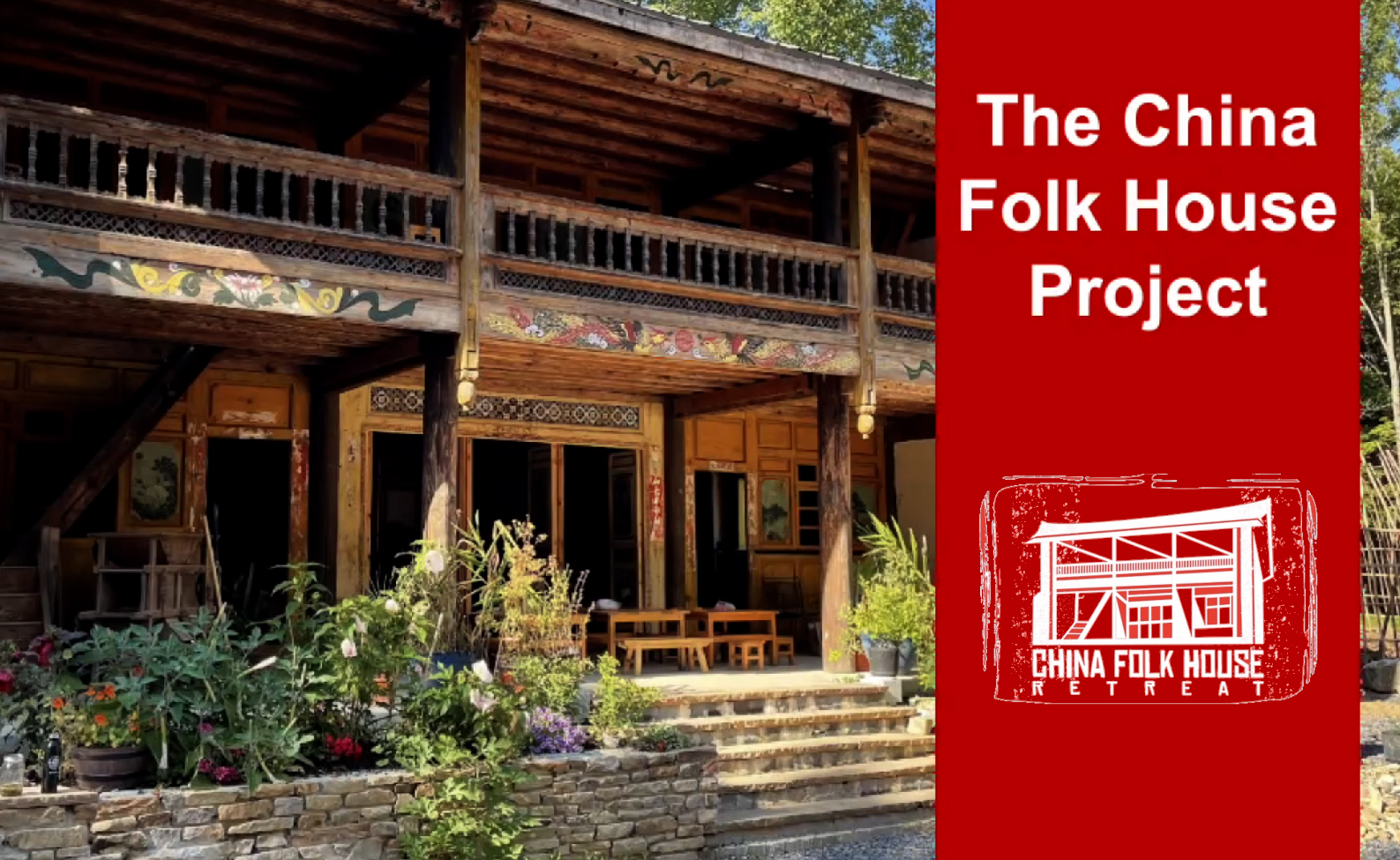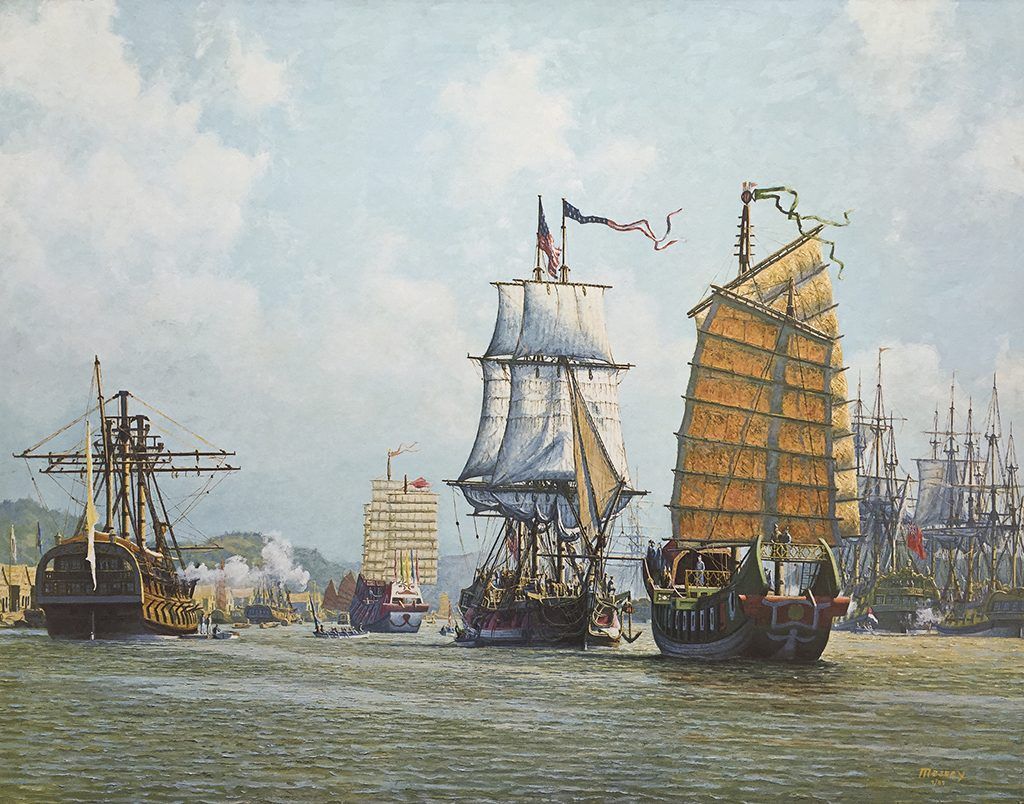
1776年7月4日是美国建国,然后经历从1775年至1783年长达8年的独立战争,迫使英国承认美国独立。为走出战争后经济危机和英国贸易禁运的带来的困境境,美国银行家、商人罗伯特·莫里斯建议政府派船到中国寻求新的商机,帮助美国渡过难关。这是一个发展中的国家,对一个发达国家的期盼。
“中国皇后号”,向大清致敬的美国船
说干就干,莫里斯联合纽约商界著名人士,投资12万美元,共同购置了一艘360吨的术制军舰,配有各种新式航海设备。为讨好中国,他们将这艘改装商船起名为“中国皇后号”(The Empress Of China)。莫里斯将从海军中挑选出来的格林聘为船长,并邀请山茂召作为他的商务代理人。
独立战争胜利的第二年,1784年1月30日,美国政府给该船颁发加盖了美利坚合众国大印的航海证书,因为无法估计到中国当时的国体政情,美国人在证书上空前绝后地写上了无数头衔:君主、皇帝、国王、亲王、公爵、伯爵、男爵、勋爵、市长、议员……为隆重起见,甚至连起航日期也精挑细选,最后选定了一个当时公认的“黄道吉日”:1784年2月22日——首任总统华盛顿的生日。一条中等级美国商船就这么冒险驶上了通往东方的航路。
今天的中国人了解“中国皇后号”多是通过美国人的一部专著。1984年美国费城海事博物馆,在纪念“中国皇后号”首航广州200周年的时候,出版了菲利普·查德威克·福斯特·史密斯《中国皇后号》一书。此书引起了早就忘了“中国皇后号”这件事的中国人的兴趣,2007年广州出版社出版了《中国皇后号》的中文版,公众这才知道,“海上丝绸之路”还有一段中美贸易传奇。
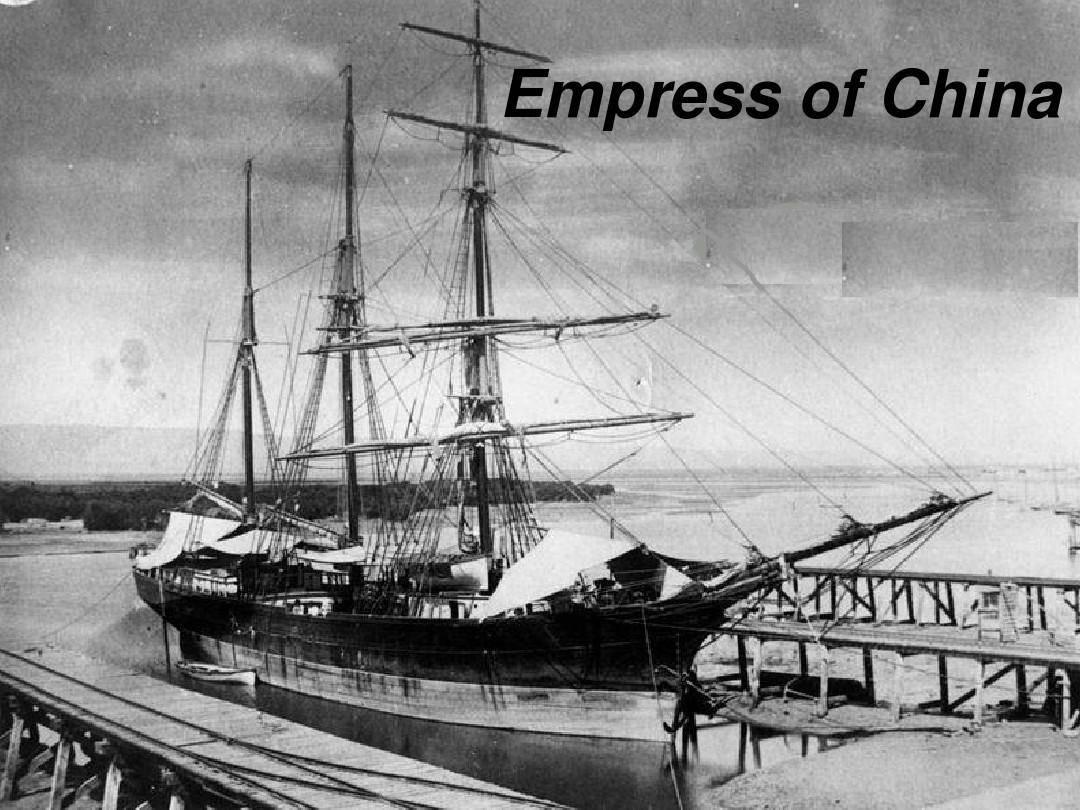
停泊在纽约的“中国皇后号”
那么,大清国与美国当时相互都有什么贸易需求呢?
据记载,当年“中国皇后号”载着473担两洋参、2600张毛皮、1270匹羽纱、26担胡椒、476担铅、300多担棉花及其他商品——驶向中国。后来,澳门出版《中国丛报》特别介绍过西洋参在中国销售的重要性:“产于鞑靼和美洲,从美洲又出产到中国,大多数医生把它看成灵丹妙药,也成为鞑靼皇帝的财物,每年赐给下面宠信的臣子……”,此后,美国商船,每来中国必定带西洋参到中国销售。
1784年8月,“中国皇后号”终于到了当时作为中国海上门户之一的澳门,在这里取得了一张盖有清廷官印的“中国通行证”,获准进入珠江,在大清领航员的带领下,“中国皇后号”经过一天的航行,抵达广州的黄埔港。“中国皇后号”呜礼炮十三响(代表当时美国的十三个州)。格林船长曾有一则这样的手记:“‘中国皇后号’荣幸地升起了在这海域从未有人升起或看见过的第一面美国国旗,这一天是1784年8月28日。”当时的两洋画家创作了一幅《“中国皇后号”到达广州》,记录下了这一中国美海上贸易的重要场景。
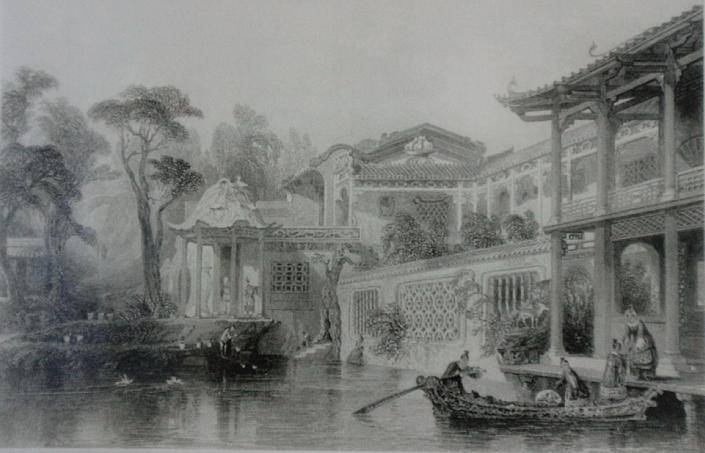
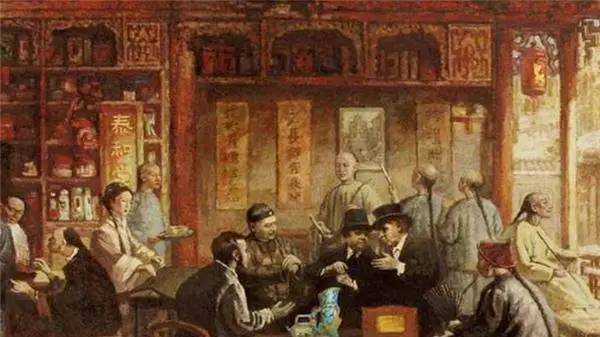
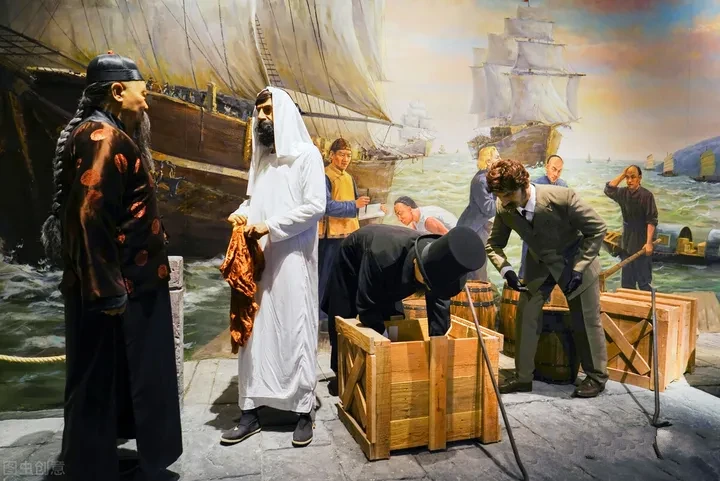
欧洲铜版画中的广州十三行风景
4个月后,“中国皇后号”的货物已全部脱手,并采办了一大批中国货:红茶2460担、绿茶562担、瓷器962担,还有大量丝织品、象牙扇、梳妆盒、手工艺品等等,船长格林本人,还购买了男士缎裤300余条、女士长袖无指手套600副、象牙扇100把。美国商人心满意足地踏上归程。
1785 年 5 月 11 日,“中国皇后号”回到纽约,往返历时 15 个月。“中 国 皇后号 ”回到纽约后,立刻刊登出售 中 国商品的广告。结果, 12 万美元购得的中国货,立即销售一空。华盛顿本人也购买了 302 件瓷器及绘有图案的茶壶、精美象牙扇等中国货。这些物品仍有部分保留在美国宾州博物馆和华盛顿故居内(第二次“中国皇后号”的中国之行,华盛顿夫人特别点名要买一批中国白瓷) 。
这次航行的美同商人获利只有3万多美元,但它开启了新的贸易窗口,挣脱了英国的经济封锁,这对当时的美国实在是太重要了。所以,相关人等被纷纷提拔,莫里斯一跃成为美国联邦政府第一任财政部长;船长格林则成为后来与中国通商的著名顾问,而商务代理人山茂召更是声名鹊起。山茂召回到美国后,立刻向当时联邦政府的外交国务秘书约翰·杰伊递交了“‘中国皇后号’访华报告”,报告赞许了中国人的好客和宽厚,极力倡导对华贸易。国会经讨论后,面向全国发布了对此次航行的表扬信,一时间,引发了全美的“中国热”。
“广州”:美国小城最喜欢起的名字
清初,以广州为目的地的海上贸易航线已有多条,“中国皇后号”的到来,又增加了一条美国直达广州的航线。作为当时中国主要对外贸易的唯一港口的广州,则成为吸引美国的最著名城市。
29岁商务代理人山茂召在他的首航中国日记中说:“虽然这是第一艘到中国的美国船,但中国人对我们却非常的宽厚。最初,他们并不能分清我们和英国人的区别,把我们称为‘新公民’,但我们拿美国地图向他们展示时,在说明我们的人口增长和疆域扩张的情况时,商人们对我围拥有如此之大的,可供他们帝国销售的市场,感到十分的高兴。”
1786年1月,山茂召因对中美贸易的贡献被美国任命为驻广州领事,山茂召一任5年,此间,不仅有几百吨的大商船前往中国,连一些几十吨的小船也载着有限的货物驶向广州,在通往中同的航线上,美国商船绵延不断,成为一大奇观。美国商船多次来广州的成功贸易,吸引了更多的美国商人投资这一贸易,波士顿商人竞发行每股300美元的大额对华贸易股票。
1793年2月,山茂召踏上了第4次中国之旅。11月2日,山茂召一行从孟买顺利到达了广州,但是次年3月他乘坐“华盛顿号”返航时,肝病恶化,客死返航途中,时年39岁,从而结束了他10年问往返中美的辉煌贸易生涯。而此时,中美海上贸易已经迅速超过荷兰、丹麦、法国,仅次于英国,排在世界的第二位。
由于当时中国对外贸易窗口,只剩下广州一地通商,所以,广州成了成功与繁荣的代名同,令没能来中国的美国人艳羡不已。因此,很多美国城镇就以“广州”(Canton)命名,而显其时尚。据说,美同的第一个“广州”,出现于1789年的乌萨诸塞州东部诸福克县的广州镇。后来,义有了俄亥俄州东北部的“广州”,它是美国最大的“广州”。美国学者乔治·斯蒂华特在一本研究美国地名的著作中曾提到:当时,在美国23个州里,都有以广州命名的城镇或乡村。与“广州”大热相反的是,大清最有学问“一代硕学”阮元在当两广总督时,于清嘉庆二十二年(1817年)编著《广州通志》,竟然还把美国说成是“在非洲境内”。
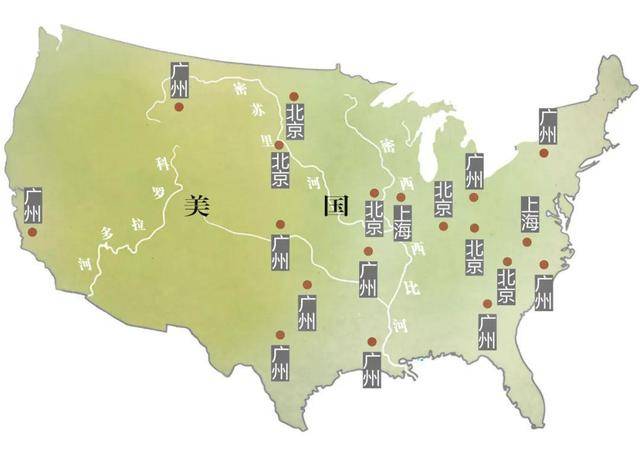
美国山寨中国的地名
藏在方尖碑里的里程碑
现在到美国旅游的人,都少不了到华盛顿转一转。但很少有人注意到华盛顿纪念碑即著名的方尖碑里还有一段中国故事。此碑高169.045米,碑内有50层铁梯,也设有70秒到顶端的高速电梯,在纪念碑内墙镶嵌着188块由私人、团体及全球各地捐赠的纪念石,其中就镶嵌有一块中文石碑,碑高1.6米,宽1.2米,它是“中国皇后号”首航中国70年后,于清咸丰三年(1853年)由中国漂洋过海,赠予美国,作为送给华盛顿纪念碑的特殊礼品。
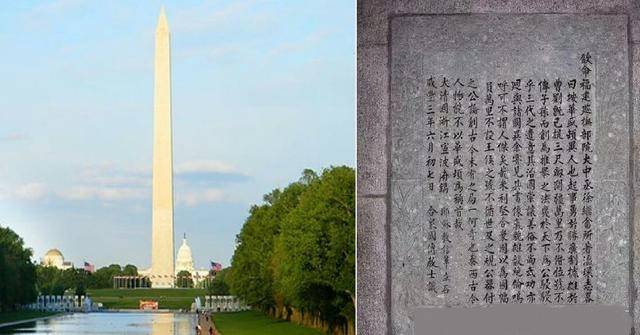
华盛顿纪念碑和纪念碑上镶嵌的中文碑
需要指出的是,此碑并非大清政府所送,碑文落款:“大清国浙江宁波府镌,耶稣教信辈立石,合众国传教士识。”这位刻石的宁波知府,名叫毕永绍,上任不到一年,就离职了。碑文正文是由美国传教士丁韪良推荐,它来自曾任福建巡抚的徐继畲所著《瀛环志略》。此书初刻于道光二十八( 1848年),后来被清廷查禁了。徐继畲是中国最早的“美国通”,他第一次把华盛顿介绍到了中国:“华盛顿,异人也。起事勇于胜、广,割据雄于曹、刘。既已提三尺剑,开疆万里,乃不僭位号,不传子孙,而创为推举之法,几于天下为公,骎骎乎三代之遗意。其治国崇让善俗,不尚武功,亦迥与诸国异”、“呜呼,可不谓人杰矣哉!米利坚合众国以为围,幅员万里,不设王侯之号,不循世及之规,公器付之公论,创古今未有之局,一何奇也!泰丙古今人物,能不以华盛顿为称首哉!”这两段赞美华盛顿话,通过立石刻碑,送到美国,也让美国人第一次知道了中国还有人如此赞美美国领袖。
如果我们细想一下,徐继畲的《瀛环志略》,仅比魏源六十卷本《海国图志》晚了1年。但在“制夷”与“开眼向洋”的方向上,则大有不同,而比之托克维尔的1840年完成《论美国的民主》仅晚了8年。
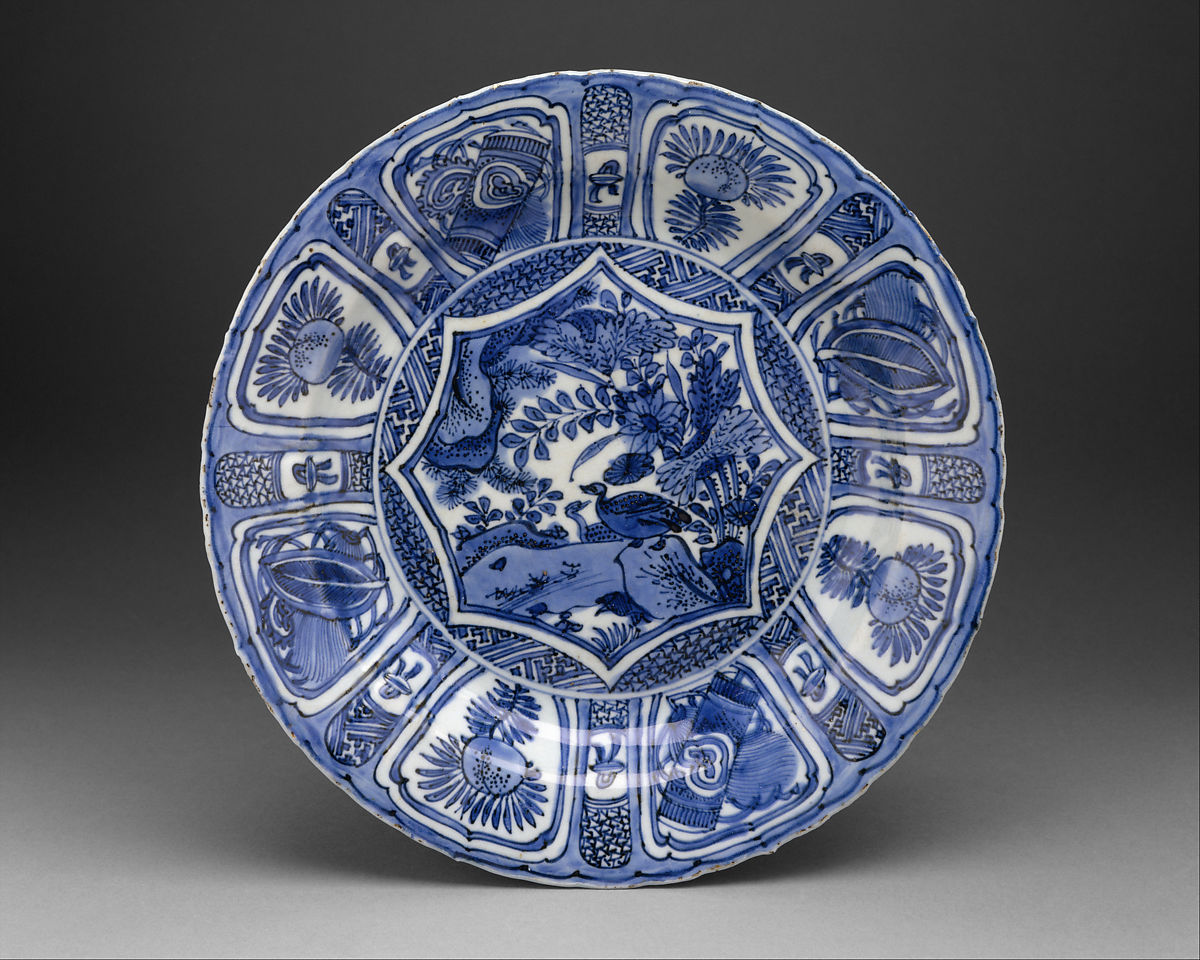
1 Acknowledgements: The author wishes to thank the Paul Mellon Centre for Studies in British Art, London, for providing support for work on this article through the grant of a postdoctoral fellowship.
See Jennifer Chen, Julie Emerson and Mimi Gates, eds., Porcelain Stories: From China to Europe (Seattle: University of Washington Press, 2000) ; John Ayers, et al., Porcelain for Palaces: the Fashion for Japan in Europe 1650-1750 (London: Oriental Ceramic Society, 2001) For a history of the imports and collections of Chinese porcelain see chapter 1 of Stacey Pierson, Collectors, Collections and Museums: The Field of Chinese Ceramics in Britain, 1560-1960, (Bern: Peter Lang, 2007).
2 Oliver Impey, “Japanese Export Porcelain”, in Porcelain for Palaces, 25-35.
3 Rose Kerr, “Missionary Reports on the Production of Porcelain in China”, Oriental Art, 47. 5 (2001): 36-37.
4 For a definition of these terms, see Krzysztof Pomian, Collectionneurs, amateurs et curieux, Paris, Venise : xvie-xviiie siècle, Paris, Gallimard, 1987.
5 Anna Somers Cocks, “The Nonfunctional Use of Ceramics in the English Country House During the Eighteenth Century”, in Gervase Jackson-Stops, et al., The Fashioning and Functioning of the British Country House, Studies in the History of Art 25 (New Haven: Yale UP. 1989).
6 The collection bore the name “the Museum Tradescantium or a Collection of Rarities Preserved at South Lambert neer London by John Tradescant of London”. Cited in Douglas Rigby, and Elizabeth Rigby, Lock, Stock, and Barrel: the story of collecting (London: J.B. Lippincott Co., 1944), 234.
7 Mercure Galant (juillet 1678), cited in Hélène Belevitch-Stankevitch, Le Goût chinois en France. 1910. (Genève: Slatkine, 1970), 149.
8 See John Ayers in Oliver Impey and Arthur MacGregor, eds., The Origins of Museums: The Cabinet of Curiosities in Sixteenth- and Seventeenth-Century Europe (Oxford: Clarendon, 1985), 256-266 and Oliver Impey, “Collecting Oriental Porcelain in Britain in the Seventeenth and Eighteenth Centuries”, in The Burghley Porcelains, an Exhibition from the Burghley House Collection and Based on the 1688 Inventory and 1690 Devonshire Schedule (New York: Japan Society 1990), 36-43.
9 See Pierson 31-33.
10 See Oliver Impey, “Porcelain for Palaces”, in Porcelain for Palaces, 56-69.
11 Cited in Joan Wilson, “A Phenomenon of Taste: the Chinaware of Queen Mary II” Apollo 126 (August 1972): 122. For the decoration of Kensington Palace, see Rosenfeld Shulsky, “The Arrangement of the Porcelain and Delftware Collection of Queen Mary in Kensington Palace,” American Ceramic Circle Journal 8 (1990): 51-74; T.H. Lunsingh Scheurleer, “Documents on the Furnishing of Kensington House,” Walpole Society 38 (1960-1962): 15-58, and Oliver Impey and Johanna Marshner, “ʽChina Mania’: A Reconstruction of Queen Mary II’s Display of East Asian Artefacts in Kensington Palace in 1693”, Orientations (November 1998).
12 For more information on the arrangement of porcelain in these rooms, see Robert J. Charleston, “Porcelain as a Room Decoration in Eighteenth-Century England,” Magazine Antiques 96 (1969): 894- 96.
13 Impey, and Ayers, Porcelain for Palaces, 56-57.
14 Hilary Young, English Porcelain, 1745-1795: its Makers, Design, Marketing and Consumption. (London: Victoria and Albert Publications, 1999), 167-69.
15 See Tessa Murdoch, Noble Households. Eighteenth century inventories of great English houses, (Cambridge: John Adamson, 2006).
16 For studies on chinoiserie, see Hugh Honour, Chinoiserie: the Vision of Cathay (London, 1961); Oliver Impey, Chinoiserie: the Impact of Oriental Styles on Western Art and Decoration (London, 1977); Vanessa Alayrac-Fielding, “Dragons, clochettes, pagodes et mandarins: Influence et representation de la Chine dans la culture britannique du dix-huitième siècle (1685-1798)”, unpublished PhD thesis, Université Paris 7 Denis Diderot, Paris, 2006 ; David Porter, The Chinese Taste in England (Cambridge: Cambridge University Press, 2010).
17 Collett-White 48.
18 The poem depicts the drowning of Walpole’s cat Selima while attempting to catch a goldfish in the porcelain tub. For a study of Walpole’s ceramic collection, see Timothy Wilson, “ʽPlaythings Still?’ Horace Walpole as a Collector of Ceramics,” in Michael Snodin and Cynthia Roman, eds., Horace Walpole’s Strawberry Hill (New Haven, CT: Yale U.P, 2009).
19 For more information on Beckford’s collections, see Derek Ostergard, ed., William Beckford, 1760-1844: An Eye for the Magnificent (New Haven and London: Yale University Press, 2001).
20 See Craig Clunas, ed., Chinese Export Art and Design (London: Victoria and Albert Museum, 1987).
21 John Stalker and George Parker, Treatise of Japanning and Varnishing Being a Complete Discovery of these Arts. (Oxford, 1688), Preface.
22 Sigmund Freud, “Fetishism,” in Adam Phillips, ed., Sigmund Freud: the Penguin Reader, (London: Penguin Books, 2006), 91-93.
23 The World n°38 (20 September 1753).
24 I draw here upon William Pietz’s anthropological study of the history and origin of the term “fetish”. See his articles on the subject, “The Problem of the Fetish, I,” Res 9 (Spring 1985), and “The Problem of the Fetish, II: the Origin of the Fetish,” Res 13 (Spring 1987).
25 The World No. 38 (20 September 1753).
26 See Chapter 3 in David Porter’s The Chinese Taste in England, 57- 93.
27 Catherine Lahaussois uses the expression “broderies de porcelaine” in Antoinette Hallé, De l’immense au minuscule. La virtuosité en céramique, (Paris : Paris musées, 2005) 48.
28 For a study of the Duchess of Portland’s passion for conchology, see Beth Fowkes Tobin, “The Duchess's Shells: Natural History Collecting, Gender, and Scientific Practice”, in Maureen Daly Goggin and Beth Fowkes Tobin, eds., Material Women, 1750-1950 (London: Ashgate, 2009), 301-325.
29 See Elizabeth Kowaleski-Wallace, Consuming Subjects: Women, Shopping, and Business in the 18th Century (New York: Columbia UP, 1997) 20-29; David Porter, “Monstrous Beauty: Eighteenth-Century Fashion and the Aesthetics of the Chinese Taste.” Eighteenth-Century Studies 35.3 (2002): 395-411.Vanessa Alayrac-Fielding, “Frailty, thy Name is China: Women, Chinoiserie and the threat of low culture in 18th-century England”, Women’s History Review, 18.4 (Sept 2009): 659-668; Stacey Sloboda, “Porcelain Bodies: Gender, Acquisitiveness and Taste in 18th-century England”, in John Potvin and Alla Myzelev, eds., Material Cultures, 1740-1920 (London, 2009), 1-36.
30 William Park. The Idea of Rococo (Newark: University of Delaware Press, 1993), 75-77.
31 See chapter 4 in Parker’s The Idea of Rococo, 96-106. For a study of history of the rococo and its presence in English decorative arts, see Michael Snodin ed., Rococo Art and Design in Hogarth’s England (London: V&A Publication1984) and Charles Hind, ed., The Rococo in England. A symposium (London: Victoria and Albert Museum, 1986).
32 The Spectator no. 37, 12 April 1712.
33 Ibid.
34 “The senses at first let in particular ideas, and furnish the yet empty cabinet, and the mind by degrees growing familiar with some of them, they are lodged in the memory, and names got to them.” John Locke, An Essay Concerning Human Understanding (1690) Book II, Chapter II, section 15.
35 Alain Bony, Léonora, Lydia et les autres : Etudes sur le (nouveau) roman (Lyon: PUL, 2004), 9-12.
36 Claude Lévi-Strauss, Le Cru et le cuit, (Paris : Plon, 1978).
37 Batty Langley, Practical Geometry, (1726), 101.
38 The World No. 38 (20 September 1753).
39 For a study of the sensualist aesthetic of chinoiserie, see Vanessa Alayrac-Fielding, “De l’exotisme au sensualisme: réflexion sur l’esthétique de la chinoiserie dans l’Angleterre du XVIIIe siècle”, in Georges Brunel ed., Pagodes et Dragons: exotisme et fantaisie dans l’Europe rococo (Paris Musées: Paris, 2007), 35-41.
40 Philippe Minguet, L’Esthétique du rococo. (Paris : Vrin, 1966).
41 See Vanessa Alayrac-Fielding, “Dragons, clochettes, pagodes et mandarins”, 103-119.

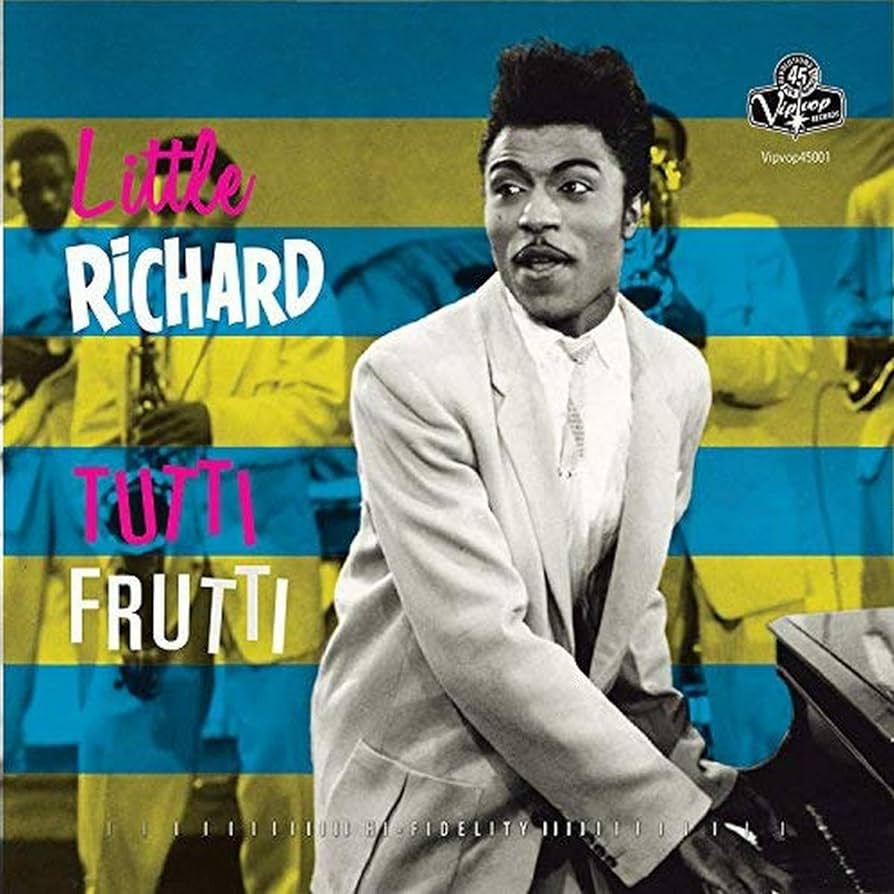
Tutti Frutti (italienisch für "alle Früchte") ist ein Song von Little Richard und Dorothy LaBostrie, der 1955 aufgenommen wurde und sein erster großer Hit war. Mit seinem energiegeladenen Refrain, der oft als "A-wop-bop-a-loo-mop-a-lop-bam-boom!" (eine verbale Wiedergabe eines Schlagzeugmusters, das sich Little Richard ausgedacht hatte), seinem treibenden Sound und seinem wilden Text wurde der Song nicht nur zum Vorbild für viele zukünftige Little-Richard-Songs, sondern auch für den Rock 'n' Roll selbst. Der Song führte einige der charakteristischsten musikalischen Merkmale der Rockmusik ein, darunter die laute Lautstärke, der kraftvolle Gesangsstil und der unverwechselbare Beat und Rhythmus.

The China Folk House Retreat is a Chinese folk house in Harpers Ferry, West Virginia, United States, reconstructed from its original location in Yunnan in China. A non-profit organization dismantled and rebuilt it piece by piece with the goal to improve U.S. understanding of Chinese culture.
History
John Flower, director of Sidwell Friends School's Chinese studies program, and his wife Pamela Leonard started bringing students to Yunnan in 2012 as part of a China fieldwork program. In 2014 Flower, Leonard, and their students found the house in a small village named Cizhong (Chinese: 茨 中) in Jianchuan County of Yunnan, China. Before the COVID-19 pandemic, they brought dozens of 11th and 12th-grade students to Yunnan to experience the cultural and natural environment of this province every spring. The architectural style of this house is a blend of Han, Bai, Naxi and Tibetan styles.
The Cizhong Village is located in eastern Himalaya, alongside the Mekong River. It has a long history of Sino-foreign cultural exchanges. The Paris Foreign Missions Society established the Cizhong Catholic Church in 1867. When they visited the village, Zhang Jianhua, owner of the house, invited them to his home. Zhang told them that the house was built in 1989, and would be flooded by a new hydroelectric power station. While the government built a new house for him one kilometer away, Flower came up with the idea of dismantling the house and rebuilding it in the United States. This house was built using mortise and tenon structure, which made it easy to be dismantled.
Logistics
Flower and his students visited Zhang several times and eventually bought the house from him. After measurements and photographing, the whole house was dismantled, sent to Tianjin and shipped to Baltimore, and finally to West Virginia. Since 2017, they have spent several years rebuilding the house in Harpers Ferry, at the Friends Wilderness Center, following the traditional Chinese method of building. For the development of this project, Flower and Leonard formed the China Folk House Retreat.


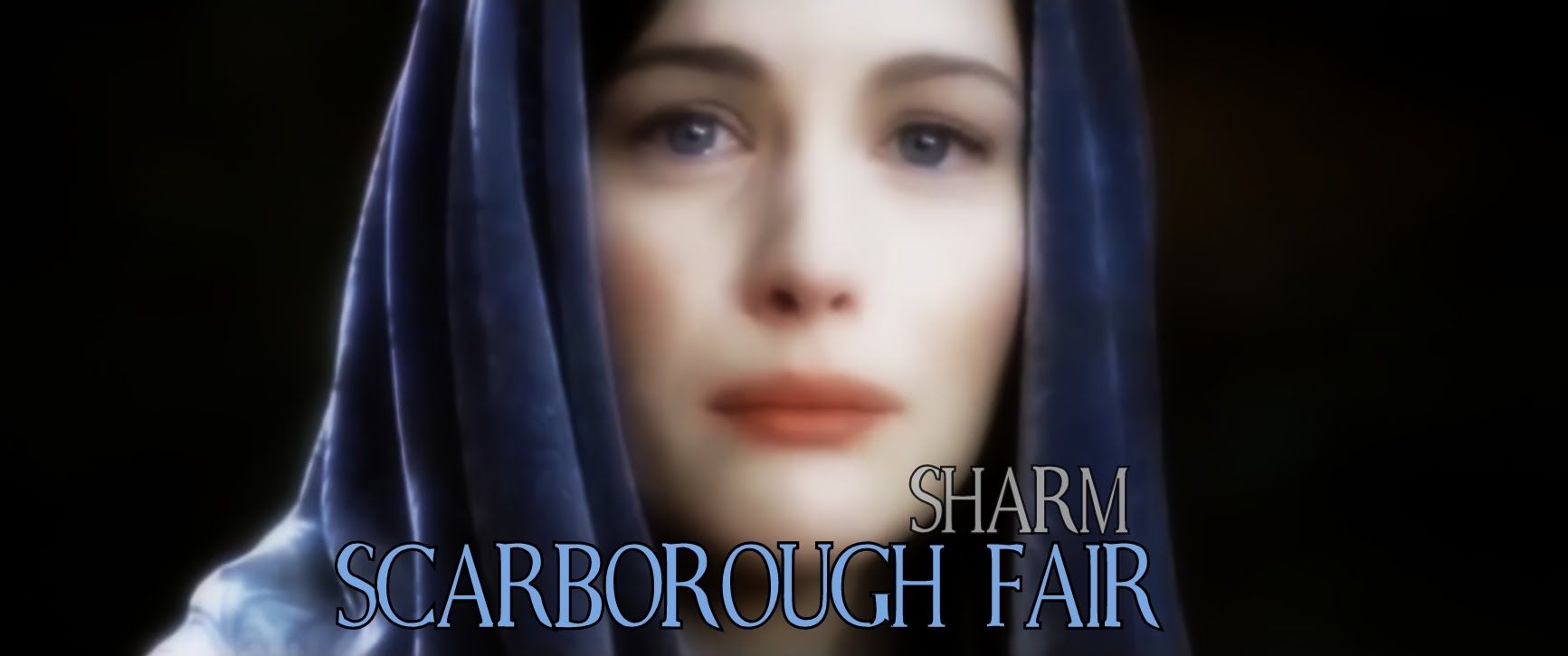
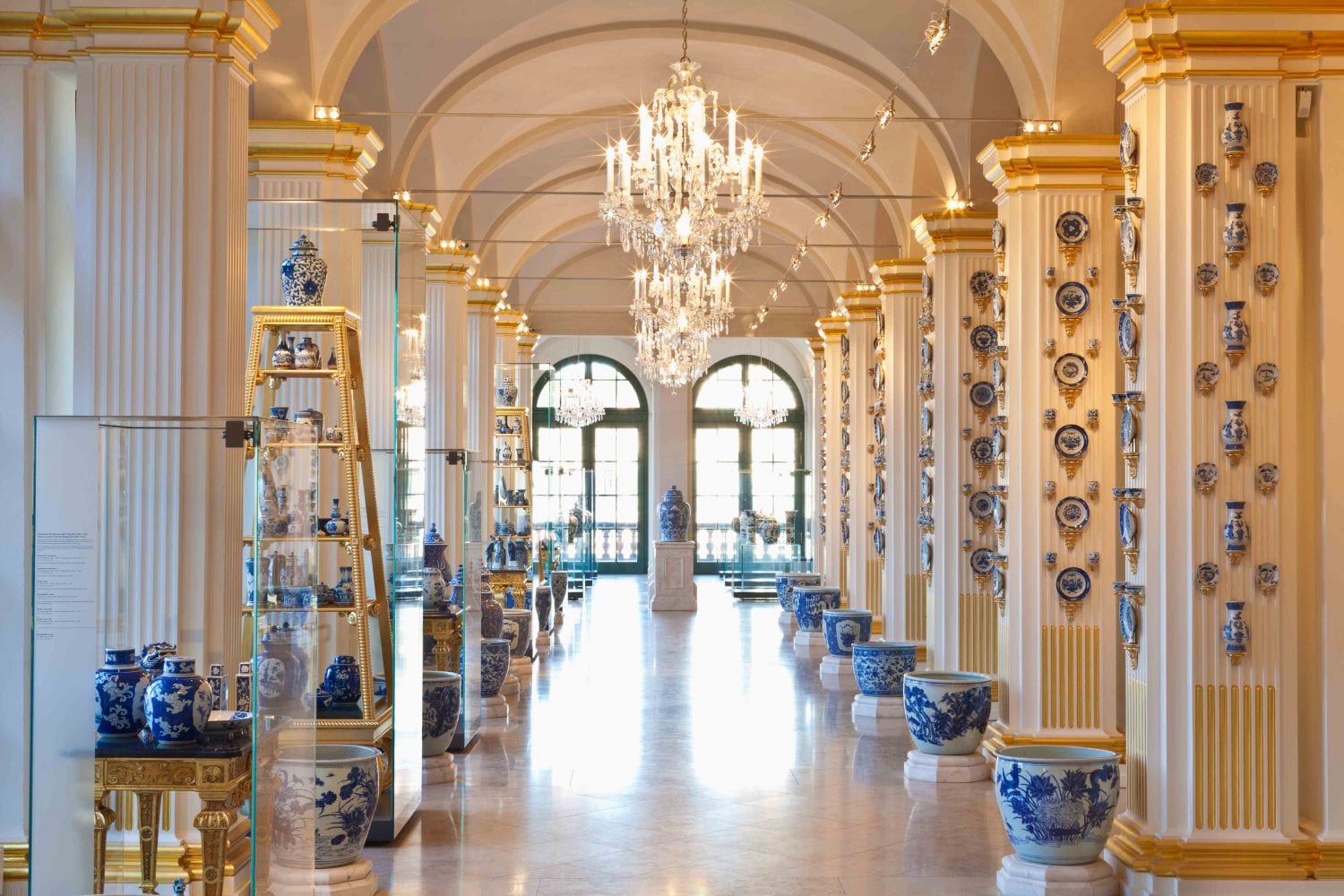
The present article seeks to analyze the presence and the symbolical meaning of oriental, and in particular Chinese, porcelain in English interiors in the 17th and 18th centuries. It examines how porcelain, through its dual status as both a natural and artificial artifact, and its exotic association with the Far East, contributed to the development of the rococo in the decorative arts in England and became a metonymy for women and the female material world.
From its first modest arrival in English interiors in the early 17th century to its role in the 18th-century craze for chinoiserie, oriental porcelain always held a significant place in interior decoration. Its function and status varied according to the place where it was displayed, from cabinets of curiosities to china closets and the tea-table. Chinese and Japanese porcelain also carried a set of different, sometimes antithetical meanings according to the type of collectors who acquired them and the way they were organised and arranged in the home. Chinamania was closely associated with women in the modern period, which led to gendered perceptions of porcelain, with the china closet becoming a metonymy for woman. In this essay, I trace the evolution of oriental porcelain in English interiors and unearth the symbolic, semiotic and cultural meanings of its presence in English men and women’s collections by bringing new material and new approaches into research on chinoiserie. I first examine the cultural and stylistic meaning of 17th-century porcelain collections to show that the fascination for porcelain items was grounded in their ambiguous status as curious, natural and artistic objects. I then turn to the case study of the furnishings of Colworth House in Bedfordshire to analyse the social function of porcelain as a signifier of taste, conspicuous consumption and status. This is followed by an interpretation of porcelain along gendered lines, in which I suggest that porcelain functioned as a memento and a fetish. Lastly, I offer a reading of the china closet which can be construed, I argue, as a feminine, rococo and “artinatural” space that epitomises the perceived characteristics of porcelain in the 18th century.
Quelle:Vanessa Alayrac-Fielding Miranda is licensed under a Creative Commons Attribution-NonCommercial-NoDerivatives 4.0 International License.


The foundation of the East India Company in 1600 made direct trade with China possible and led to an increase in English imports of Chinese wares. Although Chinese porcelain started to reach England in higher quantities at that time, they continued to be considered as precious exotica worthy of display in cabinets of curiosities. Most Chinese porcelain imported in the 17th century consisted of blanc-de-Chine and blue and white ware. Brown Yixing stoneware was also imported, as well as monochrome-glazed porcelain1. In the middle of the 17th century, direct trade with China was hampered by wars of succession within the Chinese empire, which led the East India Company to find other indirect ways of buying Chinese porcelain, and also, from 1657, to turn to Japan for more supplies in porcelain. The imports of Japanese overglazed enamelled porcelain in England provided collectors with porcelain ware of a new type: colours and new compositional patterns hitherto unknown entered English interiors2. Europe’s long-lasting fascination for porcelain can be ascribed to its beauty, its exotic provenance and the secrets surrounding its fabrication. Indeed, the manufacture of porcelain remained a mystery until the 18th century in Europe, when the alchemist Johann Böttger first succeeded in creating a porcelain body of the same type as that made in China for the Meissen factory. Until that time, porcelain had been thought to come from shells. The original Italian term porcellana, meaning “conch shell”, reflects this long-held belief3. At the end of the 17th century, speculations about its composition still ran high, as is shown by Captain William Dampier’s remark on the origin of porcelain:
The Spaniards of Manila, that we took on the Coast of Luconia, told me, that this Commodity is made of Conch-shells; the inside of which looks like Mother of Pearl. But the Portuguese lately mentioned, who had lived in China, and spoke that and the neighbouring Languages very well, said, that it was made of a fine sort of Clay that was dug in the Province of Canton. I have often made enquiry about it, but could never be well satisfied in it.
The association between porcelain and shells was further evidenced in the common practice of displaying shells and porcelain together in the 17th and 18th centuries. The Duchess of Portland had a famous collection of shells and of unique pieces of porcelain, an association which contributed to blurring the boundary between naturalia and artificialia
Porcelain first occupied a non-functional status in the cabinets of rarities and curiosities of English aristocrats5. The famous collector John Tradescant published in 1656 the first catalogue of his collection, which listed “idols from India, China and other pagan lands”6. He also possessed porcelain, some mounted with silver and gold. In the 17th century, rare and precious porcelain items were often mounted with expensive metalwork, a practice that was common throughout Europe. The Duchess of Cleveland’s collection, which was sold in France in 1672, contained very fine Chinese and Japanese pieces, according to the Mercure Galant in July 1678 : “l’élite des plus belles porcelaines que plusieurs vaisseaux de ce pays [l’Angleterre] y avaient apportées pendant plusieurs années de tous les lieux, où ils avaient accès pour leur commerce.”The Duchess’s finest porcelain pieces were gilt-mounted : “il y en avait d’admirables par leurs figures, par les choses qui étaient représentées dessus et par la diversité de leurs couleurs. Les plus rares étaient montées d’or ou de vermeil doré et garnies diversement de la même manière en plusieurs endroits”7. The adding of expensive, luxurious silver or gold mounts to the porcelain body of an object visually reinforced the latter’s precious status in the cabinet of curiosities. It also celebrated the transformative powers of artistic creation. Not unlike the popular mounted nautilus cup that stood in cabinets of rarities and curiosities, mounted porcelain held the reference to its artistic manufacture together with the allusion to its natural origin. The perceived shell-like substance of the object had undergone two transformations: it had first been moulded and fired by Oriental craftsmen to be turned into a piece of porcelain, and had then been further transformed and enhanced with precious metal by European craftsmen. Porcelain wares thus fitted into larger collections which included naturalia and artificialia, classical works of art, antiquities as well as more unusual curiosities. Although the passion for collecting porcelain was already closely connected to the realm of the feminine in the 17th century, it would be wrong to assume that men did not collect oriental porcelain. On a visit to a Mr Bohun on 30 July 1682 at Lee in Kent, John Evelyn noted the couple’s joint appreciation of Chinese and Japanese wares. The house possessed a lacquered cabinet, and it is likely that the lady’s cabinet which gets mentioned, was a china closet:
Went to visit our good neighbour, Mr. Bohun whose whole house is a cabinet of all elegancies, especially Indian; in the hall are contrivances of Japan screens, instead of wainscot; […] The landscapes of the screens represent the manner of living, and country of the Chinese. But, above all, his lady’s cabinet is adorned on the fret, ceiling, and chimney-piece, with Mr. Gibbons’ best carving. (Bray ed. 173). Quelle:Vanessa Alayrac-Fielding Miranda is licensed under a Creative Commons Attribution-NonCommercial-NoDerivatives 4.0 International License.
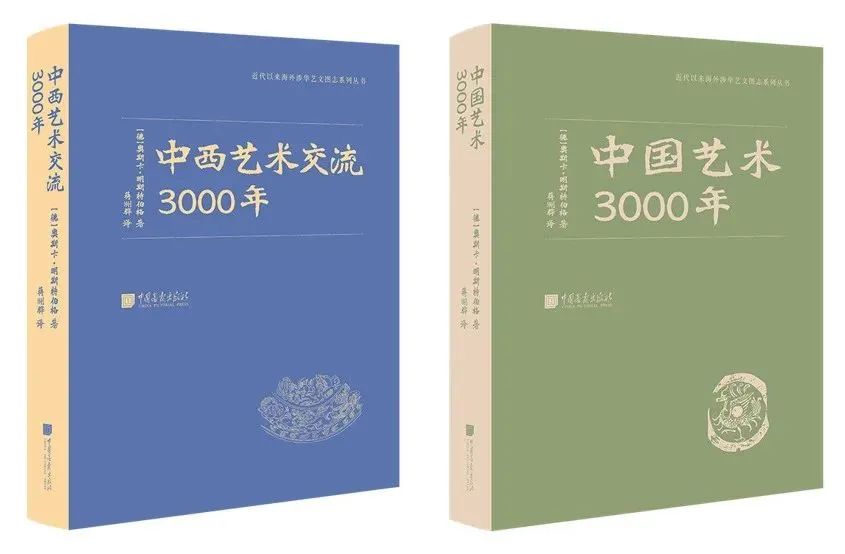
自西方历史上著名的旅游书《马可·波罗游记》诞生以后,西方与中国的往来就日渐频繁: 从15世纪末起,中国的瓷器在欧洲大受欢迎,紧接着是青铜器、漆器、象牙雕刻、绘画及家具,中国的茶叶和丝绸也成了欧洲市场上的紧俏商品。数以千计的冒险家、士兵、传教士、海员及学者,当然人数最多的是商人,来到中国。之后将无数艺术珍品带回欧洲,瞬间席卷交易市场,而各家旧大陆博物馆都得以极大地丰富了藏品,可惜它们并未对藏品质量进行筛选。这些被带回的艺术品大多被卖给了一些精致讲究的享乐主义者,而不是艺术家或艺术研究者。 由于仍缺乏对中国艺术的研究,商人购买时并不在意作品的艺术性,是否极具异域风情才是他们的评判标准。
19世纪,东亚艺术史学家奥斯卡·明斯特伯格在环游世界的旅行之后,在一次聚会与深谙艺术的同好们交流中,迸发灵感: 他计划收集到尽可能丰富的研究资料,整理归类现有的珍贵图片,在客观描述规模宏大的文献资料以外,对原作给出一些自己的评论,来还原一个较为完整的中国艺术史。
奥斯卡·明斯特伯格(Oskar Münsterberg)出生于但泽(现属波兰)的一个犹太人家庭,父亲莫里茨·明斯特伯格是一位商人,母亲安娜·伯恩哈迪是画家。父母的职业对他后来的发展道路有着极其深远的影响。明斯特伯格分别于慕尼黑和弗赖堡修习国民经济学和艺术史,从弗莱堡大学毕业后,他前往德国首都柏林,于1906年成为《德国民族报》总编。
三年后他转战莱比锡,就职成为一家出版社的社长。1912年,他重返柏林,主持哈格尔伯格出版社的主要工作。 在此期间,明斯特伯格曾多次因公来到东亚,对当地的人文产生浓厚兴趣并出版了一系列相关书籍。
第一部巨著《日本艺术史》(第一卷)于1904年问世,至1907年为止共出版三卷。 1895年发表论文《中国的改革——东亚历史政治与国民经济研究》,为他对中国艺术史的研究打下了坚实的基础,1910—1912年间,他的第二部煌煌巨著《中国艺术史》出版了。
《中国艺术史》是19世纪德国东亚艺术史学家奥斯卡·明斯特伯格的力作,系统阐释了中国辉煌博大的艺术史。 原著涵盖了从石器时代至清代的中国古代建筑、雕塑、绘画、青铜器、陶瓷、手工艺品等内容,共收录1034幅彩色图版及黑白插图和照片,每幅图片均详述器物名称、尺寸、收藏者信息等。
原著为德文版,分为两卷,分别于1910年、1912 年首次出版。两卷内容各有侧重。第一卷收录321幅黑白图版和15幅彩色图版,从历史的纵向发展,即从新石器时代至清末,诠释了中国艺术风格演化的逻辑和特质;作者又以佛教传入中国为分界线,通过中外古代石刻、青铜器、陶器、绘画、雕塑等作品,呈现了中西方三千年来在艺术上的对话交流。
第二卷分为建筑艺术和工艺美术两大部分,收录675幅黑白图版和23幅彩色图版,涵盖了中国古代建筑、青铜器、陶瓷、宝石制品、印刷品、织物、漆器与木器、琉璃、珐琅、犀角、玳瑁、琥珀、象牙等器物近1200件,通过艺术作品本身所展现的审美趣味,厘清中国艺术的发展脉络。
因原著两卷在内容上各有侧重,且论述角度不同,本次出版在保留原书完整内容的基础上,对编辑体例进行了调整,将原著两卷分别以《中西艺术交流3000年》和《中国艺术3000年》为名,单独成册出版。
在19世纪初,这部作品尝试系统地阐述中国艺术语言及其表现形式的发展历史,这在当时的学界应是史无前例的。 将其翻译、出版,对于促进学术研究和文化交流,以及了解和研究近代中国问题具有重要参考价值。

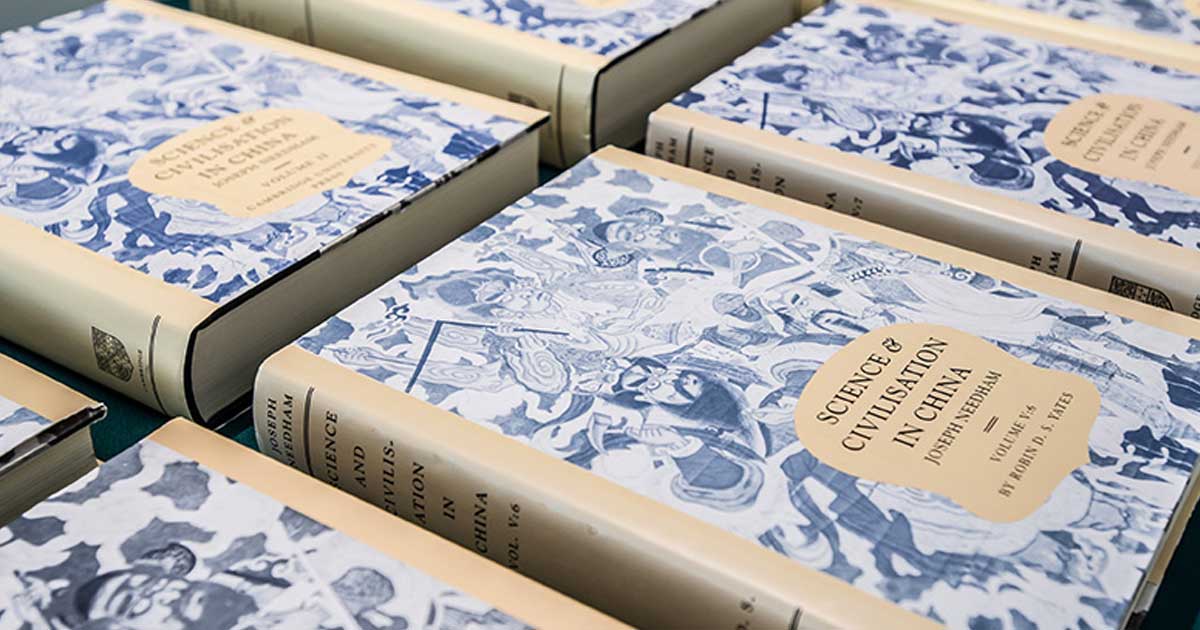
Die von dem britischen Biochemiker Joseph Needham (1900–1995) initiierte und anfangs herausgegebene englischsprachige Buchreihe zur Wissenschaft und Kultur in China setzte neue Maßstäbe in der Beschäftigung mit China im Wissenschaftsbereich. Als Standardwerk zur chinesischen Wissenschafts- und Technikgeschichte veränderte es die Wahrnehmung Chinas durch die westliche Welt und lenkte die Aufmerksamkeit auf die historischen wissenschaftlichen und technologischen Leistungen Chinas. Joseph Needham hatte das von ihm initiierte Projekt von 1954 an bis zu seinem Tod 1995 koordiniert. Zu Lebzeiten erschienen 17 Bände, weitere sieben Bände wurden seither durch das von Needham begründete Needham Research Institute herausgegeben. Das Erscheinen weiterer Bände ist in Vorbereitung. Die Gesamtanlage des Werkes ist etwas schwer zu überblicken. Die folgende Übersicht erhebt keinen Anspruch auf Aktualität oder Vollständigkeit.
| Band | Titel | Autor(en) | Jahr | Anm. |
|---|---|---|---|---|
| Vol. 1 | Introductory Orientations | Wang Ling (research assistant) | 1954 | |
| Vol. 2 | History of Scientific Thought | Wang Ling (Forschungsassistent) | 1956 | OCLC 19249930 |
| Vol. 3 | Mathematics and the Sciences of the Heavens and Earth | Wang Ling (Forschungsassistent) | 1959 | OCLC 177133494 |
| Vol. 4, Part 1 |
Physics and Physical Technology Physics |
Wang Ling (Forschungsassistent), with cooperation of Kenneth Robinson | 1962 | OCLC 60432528 |
| Vol. 4 Part 2 |
Physics and Physical Technology Mechanical Engineering |
Wang Ling (collaborator) | 1965 | |
| Vol. 4, Part 3 |
Physics and Physical Technology Civil Engineering and Nautics |
Wang Ling and Lu Gwei-djen (collaborators) | 1971 | |
| Vol. 5, Part 1 |
Chemistry and Chemical Technology Paper and Printing |
Tsien Tsuen-Hsuin | 1985 | |
| Vol. 5, Part 2 |
Chemistry and Chemical Technology Spagyrical Discovery and Invention: Magisteries of Gold and Immortality |
Lu Gwei-djen (collaborator) | 1974 | |
| Vol. 5, Part 3 |
Chemistry and Chemical Technology Spagyrical Discovery and Invention: Historical Survey, from Cinnabar Elixirs to Synthetic Insulin |
Ho Ping-Yu and Lu Gwei-djen (collaborators) | 1976 | |
| Vol. 5, Part 4 |
Chemistry and Chemical Technology Spagyrical Discovery and Invention: Apparatus and Theory |
Lu Gwei-djen (collaborator), with contributions by Nathan Sivin | 1980 | |
| Vol. 5, Part 5 |
Chemistry and Chemical Technology Spagyrical Discovery and Invention: Physiological Alchemy |
Lu Gwei-djen (collaborator) | 1983 | |
| Vol. 5, Part 6 |
Chemistry and Chemical Technology Military Technology: Missiles and Sieges |
Robin D.S. Yates, Krzysztof Gawlikowski, Edward McEwen, Wang Ling (collaborators) | 1994 | |
| Vol. 5, Part 7 |
Chemistry and Chemical Technology Military Technology: The Gunpowder Epic |
Ho Ping-Yu, Lu Gwei-djen, Wang Ling (collaborators) | 1987 | |
| Vol. 5, Part 8 |
Chemistry and Chemical Technology Military Technology: Shock Weapons and Cavalry |
Lu Gwei-djen (collaborator) | 2011[1] | |
| Vol. 5, Part 9 |
Chemistry and Chemical Technology Textile Technology: Spinning and Reeling |
Dieter Kuhn | 1988 | |
| Vol. 5, Part 10 |
"Work in progress" | |||
| Vol. 5, Part 11 |
Chemistry and Chemical Technology Ferrous Metallurgy |
Donald B. Wagner | 2008 | |
| Vol. 5, Part 12 |
Chemistry and Chemical Technology Ceramic Technology |
Rose Kerr, Nigel Wood, contributions by Ts'ai Mei-fen and Zhang Fukang | 2004 | |
| Vol. 5, Part 13 |
Chemistry and Chemical Technology Mining |
Peter Golas | 1999 | |
| Vol. 6, Part 1 |
Biology and Biological Technology Botany |
Lu Gwei-djen (collaborator), with contributions by Huang Hsing-Tsung | 1986 | |
| Vol. 6, Part 2 |
Biology and Biological Technology Agriculture |
Francesca Bray | 1984 | |
| Vol. 6, Part 3 |
Biology and Biological Technology Agroindustries and Forestry |
Christian A. Daniels and Nicholas K. Menzies | 1996 | |
| Vol. 6, Part 4 |
Biology and Biological Technology Traditional Botany: An Ethnobotanical Approach |
Georges Métailie | 2015 | |
| Vol. 6, Part 5 |
Biology and Biological Technology Fermentations and Food Science |
Huang Hsing-Tsung | 2000 | |
| Vol. 6, Part 6 |
Biology and Biological Technology Medicine |
Lu Gwei-djen, Nathan Sivin (editor) | 2000 | |
| Vol. 7, Part 1 |
Language and Logic | Christoph Harbsmeier | 1998 | |
| Vol. 7, Part 2 |
General Conclusions and Reflections | Kenneth Girdwood Robinson (editor), Ray Huang (collaborator), introduction by Mark Elvin | 2004 | OCLC 779676 |
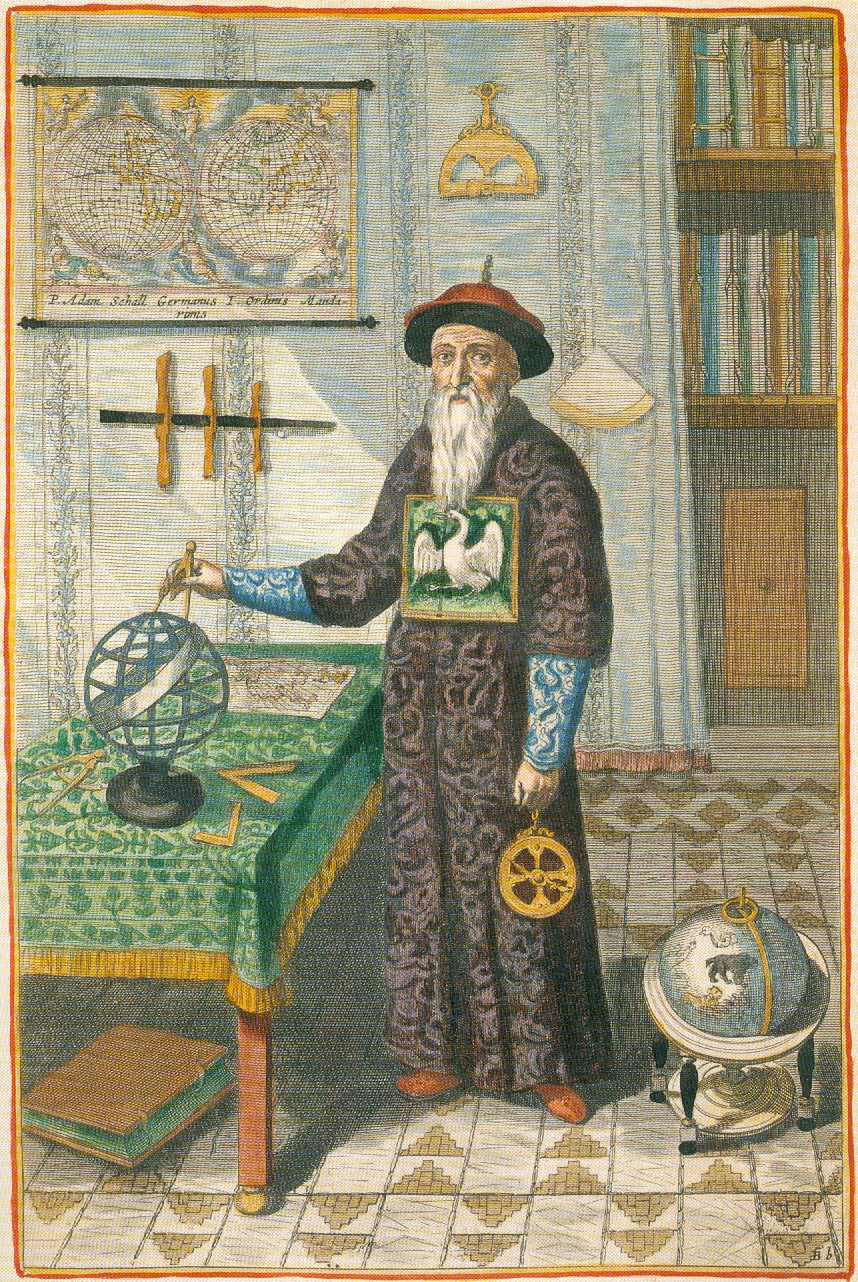
汤若望最重要的贡献之一是参与明末历局的改历、编纂修定“崇祯历书”
"窃维九万里孤踪,结知英主。既荣其生,复哀其死。鱼水相欢,得若将终其身,又预为之计,久远如此。宠施优渥,出于格外,岂人力也哉!"--汤若望墓志铭。
1660年,耶稣会传教士、德国人汤若望在中国大清皇帝顺治赐予他的茔地上建立了一座圣母小教堂。教堂前树立石碑一块,碑上便用满汉两种文字刻着上述碑文。在感激中国君主知遇之恩的同时,不远万里来到这一东方古国、当时已年近古稀、在华渡过了大半生的汤若望,并没有忘记身负的传教使命,以及对天主的景仰。
“古圣贤于遇合之际,率归之天。今予之得遇主上,用西法以定运,进修士以演教。道之将行,日升月恒,殆未可量。又不特一身之感恩称知遇而已,谓非天主上帝默作合于其间,可乎?”
随着1498年葡萄牙航海家达伽马开辟东方新航线,大批欧洲殖民者和商人相继东来。自明朝中叶起,天主教的耶稣会、方济各会和多明我会的传教士也纷纷进入中国内地,其中以耶稣会势力最大,他们逐渐由澳门深入内地,打开传教局面,使天主教在中国立下根基。就连"天主"一词也是16世纪耶稣会传教士进入中国后,借用中国人较容易接受的名称对其所信之上帝赋予的称谓,从此中国便把他们传播的宗教定名为"天主教"。耶稣会士的代表人物当首推意大利人利马窦、瑞士人邓玉函、德国人汤若望以及比利时人南怀仁等,他们甚至跻身朝廷,博得了中国皇帝的青睐。
然而,深受中国儒家思想影响,或者是笃信佛教的中国皇帝,器重这些西方传教士的原因并不在于他们的信仰,而是他们带来的先进科学技术。他们当中有天文学家、数学家、地理学家、画家、医生、音乐家、钟表匠、珐琅专家等。中国社会科学院世界宗教研究所所长卓新平教授说:
“为了在中国站稳脚跟,他们必须具备一些知识,既包括科技也包括人文方面的知识,科技知识在中国尤受欢迎。于是汤若望、纪理安等人的科技知识赢得了中国百姓,特别是学者的佩服,进而是信服,这样在信仰这个方面进行交流就要容易得多了。”
不仅如此,了解中国本土文化、尊重中国人的习俗、掌握中国语言也是耶稣会教士开启中国社会大门的一块敲门砖。曾在德国慕尼黑大学获得哲学博士学位、兼任中国基督教研究中心主任的卓新平教授说:
“当时耶稣会士东来,到了一个陌生的文化、陌生的土地上,他们要想传播他们的信仰,必须先了解这个国度,这个民族的所思所想。在了解过程中,一方面他们是吸收中国的思想文化,另一方面,又把西方的思想文化带入。”
澳门是四百年前耶稣会士进入中国的第一个落脚点。以利玛窦为代表的许多传教士们,一踏上澳门土地,便开始精心研习中国语言文化,甚至以掌握北京官话为目标。这些西方修士入乡随俗,脱下僧袍,换上儒服,住进中式房屋,并潜心研究中国经史和伦理,寻找其中东西方文化的融合点。在同朝野名流交往的过程中,这些上通天文,下知地理,又熟读汉文典籍的西方传教士,自然赢得了中国文人士大夫的好感和信任,从而达到其传播信仰的目的。1605年,名代翰林院学者、主持历局的官员徐光启受洗入教便是一例。
汤若望的贡献
继利玛窦之后,出身于德国科隆贵族世家的汤若望则是又一名活跃于明清之际的著名耶稣会传教士,而比之这位来自意大利的先驱,汤若望的在华经历可谓跌宕起伏,坎坷不平。他不仅是明朝灭亡、清兵入关的见证人,而且以其凛然正气,获得新统治者的应允,得以”留居原寓“,即今宣武门内南堂,继续其历法的修定工作。
汤若望在华四十余年,虽未能达到其传教的目的,但在将西方先进的天文学、光学、火器、矿业等领域的知识介绍到中国这方面,却取得了丰硕成果。而其最重要的贡献之一则是参与明末历局的改历、编纂修定“崇祯历书”。
明朝末年,行用多年的“大统历”误差渐大,钦天监所预报的天象,尤其是日月食屡屡失验。在用中国传统方法与西方方法预报日月食,几经校验比较之后,皇家确定由徐光启主持历局,修改历法。徐光启则聘请了邓玉函、龙华民等传教士参与改历。
1630年,汤若望奉诏从陕西调往北京进历局供职。在中西学者的共同努力下,编译了长达137卷的长篇巨著“崇祯历书”,而其中由汤若望撰写编译的就有包括“交食历指”、“恒星出没表”、“南北高弧表”、“五纬诸表”等共43卷。
除此之外,1626年,汤若望还在中国学者李祖白的协助下撰写了“远镜说”。研究西方传教士对中国科学史所做贡献的专家、北京古观象台副台长李东生女士介绍说:
“汤若望还编纂了‘远镜说’,是根据1616年德国法兰克福出版社出版的赛都利的著作编译而成的。这本书对伽利略望远镜的制作原理、功能、结构、使用方法都做了详尽的说明,通篇条理清楚、浅显易懂,图文并茂。所以专家学者认为,这是中国出版的最早的一部介绍西方光学理论和望远镜技术的启蒙著作。”
为帮助中国开采矿藏,加强国储,汤若望在历局期间,又同中国学者合作翻译了德国矿冶学家阿格里科拉(Georgius Agricola)于1550年撰写的论述16世纪欧洲开采、冶金技术的巨著“矿冶全书”(Dere Metallica Libri XII),中译本定名为“坤舆格致”。此书编成后,汤若望进呈给朝廷,崇祯皇帝御批:“发下‘坤舆格致’全书,着地方官相酌地形,便宜采取”。
不过,因战事已紧,明王朝迅速崩溃,已无暇过问“坤舆格致”的命运,因此该书未被刊行,后来也便在明末清初纷繁的战事中遗失了。而“崇祯历书”却由于汤若望挺身而出,据理力争,不仅躲过了浩劫,后来还得以颁行天下。
迭宕起伏的一生
1644年,清兵入主北京。摄政王多尔衮下达严令:“内城居民,限三日内,尽行迁居外城,以便旗兵居住“。当时住在宣武门天主堂的汤若望冒着违令受惩的危险,上疏朝廷,称:
“曾奉前朝故皇帝令修历法,著有历书多轶,付工镌版,尚未完竣,而版片已堆积累累;并堂中供像礼器、传教所用经典、修历应用书籍并测量天象各种仪器,件数甚伙。若一并迁于外城,不但三日限内不能悉数搬尽,且必难免损坏,修正既非容易,购买又非可随时寄来。”因而恳请“仍居原寓,照旧虔修”。
颇为开明的新统治者第二天便传谕:“恩准西士汤若望等安居天主堂,各旗兵弁等人,毋许阑入滋扰。”
在保护南堂及内存所有历书、仪器和传教所用经典免遭战火洗劫后,汤若望又多次奉召入朝,向新统治者力陈新历之长,并适时进献了新制的舆地屏图和浑天仪、地平晷、望远镜等仪器,而且用西洋新法准确预测了顺治元年(1644年)农历8月初一丙辰日食时,初亏、食甚、复圆的时刻,终于说服当时的摄政王多尔衮,决定从顺治二年开始,将其参与编纂的新历颁行天下。
当时汤若望等传教士得以留住的天主堂便是北京历史最悠久的一座天主教堂,以南堂著称。1605年,利马窦曾于该处建起京城内第一座经堂,但规模很小。后来,在汤若望主持下,于1650年建造了北京城内的第一座大教堂,此处成为汤若望等神父的起居地。
不过,这名曾官至钦天监监正的德国教士工作的地点则是矗立在北京建国门附近的古观象台。古观象台,原名观星台,始建于明正统七年(1442年),是世界上最古老的天文台之一,迄今已有560年的历史了。
它由一座高14米的砖砌观星台和台下紫微殿、漏壶房、晷影堂等建筑组成。在青砖台体上耸立着八件青铜铸就的宏大精美的仪器,是清代制造的天体仪、赤道经纬仪、黄道经纬仪、地平经仪、象限仪、纪限仪、地平经纬仪和玑衡抚辰仪。仪器身上刻有栩栩如生的游龙和精美绝伦的流云,其中部分甚至仍具有实测功能。
明清时代,作为钦天监外署,它是一个重要的天文观测基地。当时中国修定立法、观测天象、编制星表、制造天文仪器等活动都与西方传教士密切相关。汤若望当年工作的厅堂至今仍保存完好。北京古观象台副台长李东生女士介绍说:
“北京古观象台是西方传教士来华最早的落脚点之一,可以说是一个中西方文化交流的窗口。在古观象台工作的传教士有50多人,汤若望是其中最主要的传教士,还担任台长,即钦天监监正。”
1651年,多尔衮死,顺治皇帝爱新觉罗-福临亲政。这名清代开国皇帝虽笃信佛教,但却非常钦佩汤若望的道德与学问,并与之保持着很好的关系,先后24次到访南堂,与汤若望促膝谈心。在华西方传教士长眠的腾公栅栏墓地所在地、今北京西郊行政学院中西文化交流研究中心的研究员林华女士介绍说:
“顺治年幼,对大胡子外国老头非常好奇,多次跑到南堂去看他们是如何生活,工作和吃饭的。汤若望对宫里一些人,包括顺治的母亲,都有一定的影响。根据资料说,汤若望在宫中也发展了一批教徒,但影响不大,因为中国自己就有着各种各样的宗教,佛教、道教等,而满人是信萨满教的。虽然中国人不信西方的宗教,但很尊重这些传教士的学识。顺治还称汤若望为“玛法”,即满语爷爷之意,并赐给他很多特权,比如可以随时进入后宫等。”
这一时期,汤若望在华事业可谓达到了峰巅。岂料顺治皇帝英年早逝,于是年仅8岁的爱新觉罗-玄烨登基,年号康熙。汤若望虽经中国朝代更迭的重大变故,安然无恙,却在清廷内部的权力斗争中成为牺牲品,这便是中国历史上著名的“历案”。林华女士说:
“因为康熙是一个几岁的小娃娃,掌握实权的则是敖拜等反对洋教和西方学说的一些人。因此他们上台以后,汤若望就马上被打入底层,遭到栽赃陷害,并锒铛入狱。他当时已是一位老人,而且很快中风,不会说话。在拷打审问中,都是其助手、比利时的南怀仁替他辩护,但还是被判了死刑。这时候,北京发生大地震,于是皇太后出面为汤若望求情,才得以出狱。但健康已不能挽回,之后不久便去世了。”
康熙亲政后,铲除敖拜等人,为汤若望平反,并派大员在顺治所赐墓地上为汤若望修建坟茔,举行隆重葬礼,还率领百官及亲眷到其墓前祭奠。汤若望墓碑正面是拉丁文和中文碑文,反面是康熙皇帝以汉文和满文为其撰写的祭文。从“鞠躬尽瘁,恤死报勤,国之盛典”等用词足以见中国一代明君对这位来自万里之遥、莱茵河畔的德国传教士高度的评价和认可。
继汤若望之后,来自德国的传教士还有纪理安(Bernard-Kiliam Stumpf)、戴进贤(Ignatius Koegler)等人,他们在钦天监供职,从事天文、历法的观测和推算工作。而死后,同样埋葬在利马窦、汤若望、南怀仁、朗士宁等前辈长眠的腾公栅栏墓地。
如今,传教士们的身躯早已化作一掊黄土,留下的是这座浓荫蔽日、保存了60尊各国教士墓碑的墓园,它已成为中西方科学文化交流的一个历史见证,以及超越时空的推进人类思想文明的象征。(Quelle:德国之声 DW.com)
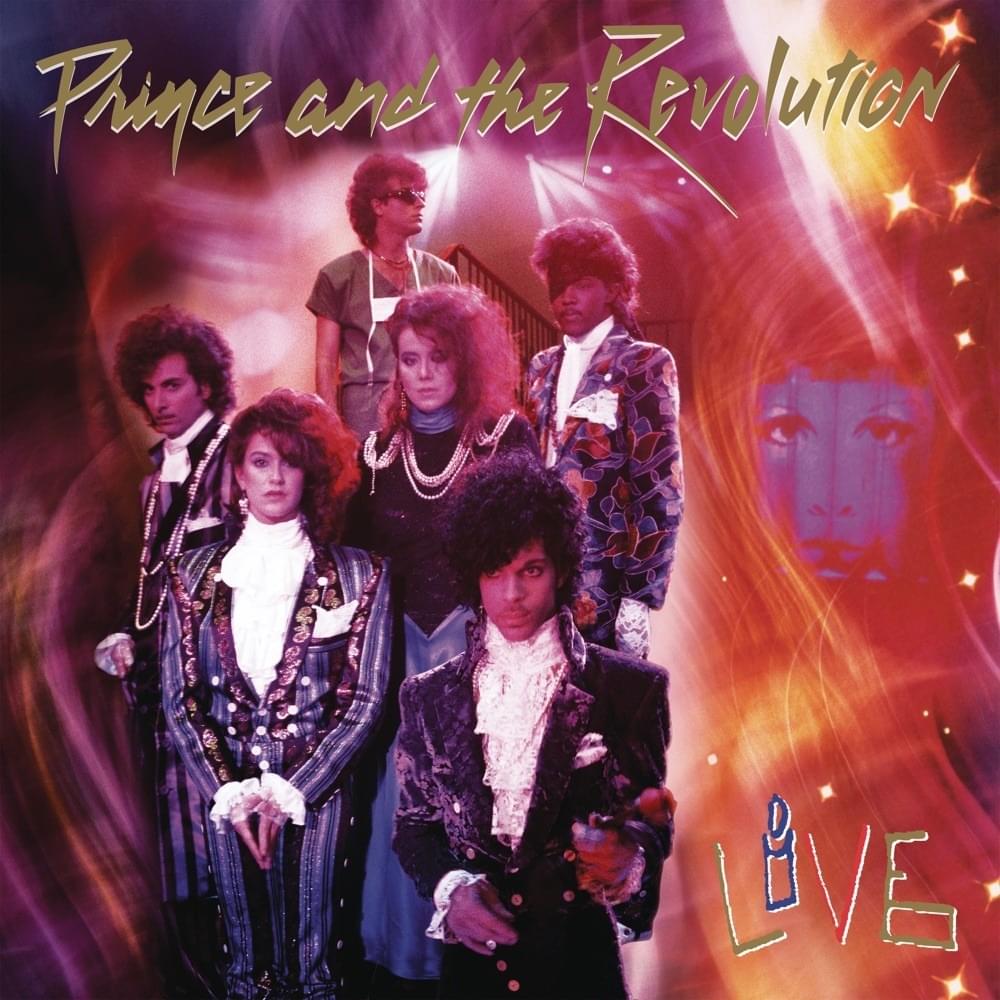


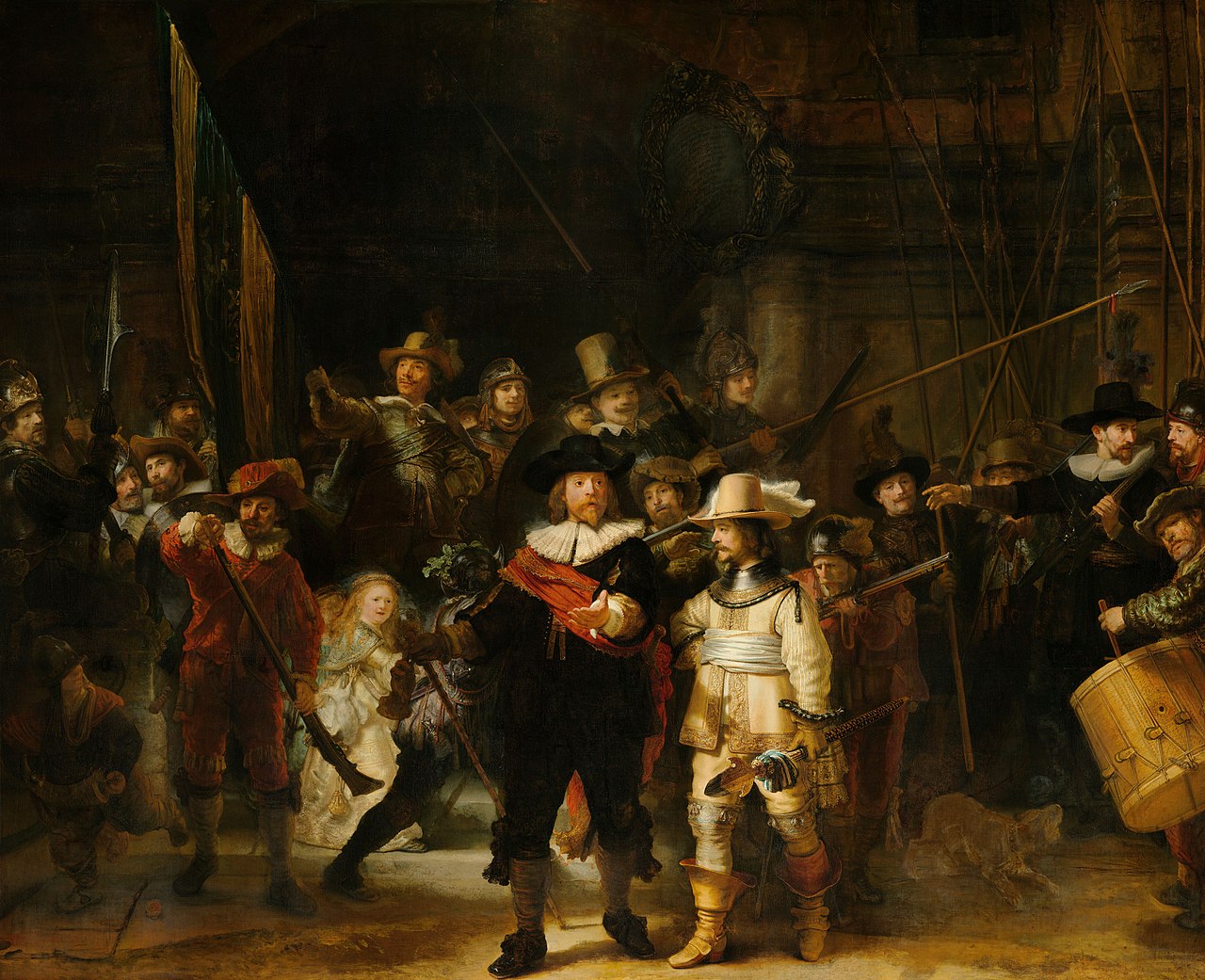
Baroque painting is the painting associated with the Baroque cultural movement. The movement is often identified with Absolutism, the Counter Reformation and Catholic Revival,[1][2] but the existence of important Baroque art and architecture in non-absolutist and Protestant states throughout Western Europe underscores its widespread popularity.[3]
Baroque painting encompasses a great range of styles, as most important and major painting during the period beginning around 1600 and continuing throughout the 17th century, and into the early 18th century is identified today as Baroque painting. In its most typical manifestations, Baroque art is characterized by great drama, rich, deep colour, and intense light and dark shadows, but the classicism of French Baroque painters like Poussin and Dutch genre painters such as Vermeer are also covered by the term, at least in English.[4] As opposed to Renaissance art, which usually showed the moment before an event took place, Baroque artists chose the most dramatic point, the moment when the action was occurring: Michelangelo, working in the High Renaissance, shows his David composed and still before he battles Goliath; Bernini's Baroque David is caught in the act of hurling the stone at the giant. Baroque art was meant to evoke emotion and passion instead of the calm rationality that had been prized during the Renaissance.
Among the greatest painters of the Baroque period are Velázquez, Caravaggio,[5] Rembrandt,[6] Rubens,[7] Poussin,[8] and Vermeer.[9] Caravaggio is an heir of the humanist painting of the High Renaissance. His realistic approach to the human figure, painted directly from life and dramatically spotlit against a dark background, shocked his contemporaries and opened a new chapter in the history of painting. Baroque painting often dramatizes scenes using chiaroscuro light effects; this can be seen in works by Rembrandt, Vermeer, Le Nain and La Tour. The Flemish painter Anthony van Dyck developed a graceful but imposing portrait style that was very influential, especially in England.
The prosperity of 17th century Holland led to an enormous production of art by large numbers of painters who were mostly highly specialized and painted only genre scenes, landscapes, still lifes, portraits or history paintings. Technical standards were very high, and Dutch Golden Age painting established a new repertoire of subjects that was very influential until the arrival of Modernism.

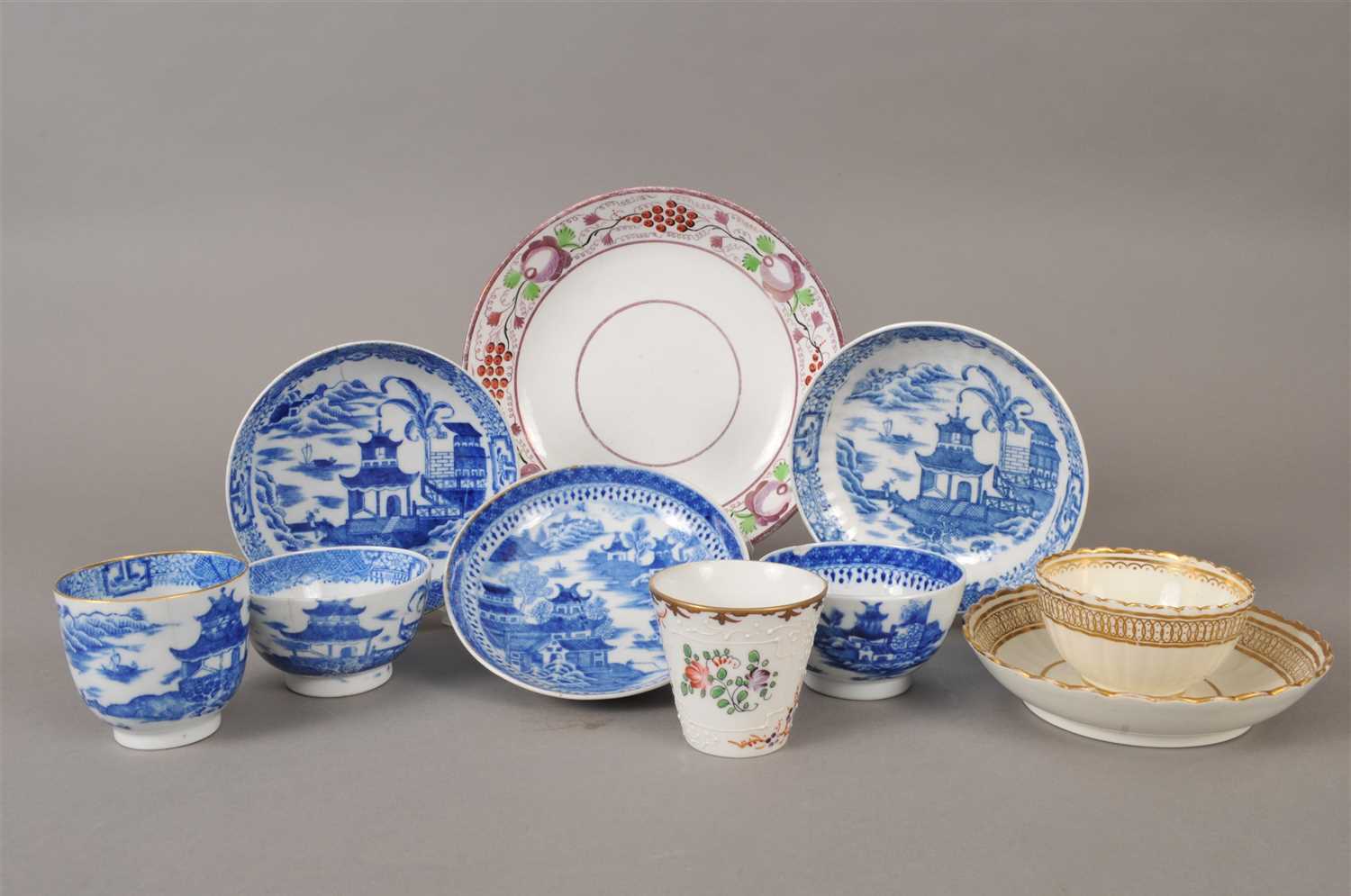
The detail of the possessions of the Antonie family at their estate at Colworth House in Sharnbrook (Bedfordshire) in the 18th century, recorded in successive inventories, provides an interesting illustration of men’s taste for porcelain. Marc Antonie was steward to the Duke of Montagu. In 1715, he bought the Colworth estate from John Wagstaff, citizen and mercer of the City of London, who had previously bought it from the Montagus. The Antonies had invested money in the South Sea stock, which resulted in the family’s financial collapse when the South Sea Bubble burst. After Marc Antonie’s death in 1720, the 1723 inventory was made with a view to selling the furniture to get the family out of debt. The presence in the inventory of porcelain dishes and basins exported from China reflects how the fashion for porcelain was connected to the ever more fashionable practice of drinking another Chinese product, tea and, to a lesser degree, coffee. The inventory records a “cheany & Teatable” in the North Parlour, advertised for £ 6 14s, and in the Hall “10 little Cheany plates that sold for £ 1 5s, 6 larg [sic] Cheany Dishes £ 1 15s, 4 Cheany Basons, Cheany mugs and Delf Dishes, Cheany Cassters and Cheany”.
The second inventory of 1771 was made after the death of Marc Antonie’s youngest son, Richard, on 26 November 1771. Richard Antonie had inherited the estate in 1768 after John’s death, Marc Antonie’s eldest son. He first established himself as a draper and then moved on to Jamaica in 1748 where he owned a sugar plantation. The furnishings of the house listed in the 1771 inventory were mostly purchased by Richard and some pieces by John Antonie. They give a good indication of the type of furnishing found in the 1760s in a country house, and, as James Collett-White points out, “reflect what a country gentleman with London connections might have purchased and collected”.
Ornamental and functional porcelain figures prominently in the inventory. Antonie had an unusually large collection of china. In the two parlours and three of the four principal bedrooms were 125 pieces of ornamental china. The inventory does not mention the provenance of the pieces and it is highly probable these porcelains were not all of Chinese origin, but would have also come from continental centres such as Delft, Meissen and France, and also from English porcelain factories such as Derby, Worcester and Bow. Non-functional porcelain was completed by a huge number of porcelain plates and dishes which were kept in the “china closet”. Two “dragon china” dishes and “Nankeen basins” get mentioned in the inventory, which confirms the presence of Chinese export porcelain in Antonie’s collection. The taste for Chinese-styled indoor and outdoor decoration, which blended authentic Chinese wares with chinoiserie, gained momentum in the century, reaching a peak in the 1750s and 1760s16. Antonie had a particular liking for chinoiserie, as he commissioned a gate or possibly a low fence of oak railings to be made in the Chinese style, which he mentioned in his notes: “Richard Antonie made a New China Work the front of his house.”It thus appears very likely that he would have collected Chinese porcelain to complement the Chinese theme set up outside his house.

Addison, Joseph and Richard Steele ed. The Spectator no. 37, 12 April 1712.
Alayrac-Fielding, Vanessa. “Dragons, clochettes, pagodes et mandarins : Influence et représentation de la Chine dans la culture britannique du dix-huitième siècle (1685-1798)”, unpublished PhD thesis, Université Paris 7 Denis Diderot, Paris
---. “Frailty, thy Name is China: Women, Chinoiserie and the threat of low culture in 18th-century England.”Women’s History Review 18:4 (Sept 2009): 659-668.
---. “De l’exotisme au sensualisme : réflexion sur l’esthétique de la chinoiserie dans l’Angleterre du XVIIIe siècle.”In Pagodes et Dragons : exotisme et fantaisie dans l’Europe rococo. Ed. Georges Brunel. Paris: Paris Musées, 2007. 35-41
Ayers, John, Impey, Olivier and J.V.G Mallet. Porcelain for Palaces: the Fashion for Japan in Europe 1650-1750. London: Oriental Ceramic Society, 1990.
Ballaster, Ros. Seductive Forms: Women’s Amatory Fiction from 1684 to 1740. Oxford: Oxford University Press, 1998.
Baridon, Michel. “Hogarth’s ʽliving machines of nature’ and the theorisation of aesthetics.”In Hogarth. Representing Nature’s Machines. Eds. David Bindman, Frédéric Ogée, and Peter Wagner. Manchester: Manchester University Press, 2001. 85-101.
Belevitch-Stankevitch, Hélène. Le Goût chinois en France. 1910. Genève: Slatkine, 1970.
Benedict,Barbara. “The Curious Attitude in Eighteenth-Century Britain: Observing and Owning.”Eighteenth-Century Life 14 (Nov. 1990): 75.
Burnaby,William. The Ladies’ Visiting-Day. London, 1701.
Bony, Alain. Léonora, Lydia et les autres : Etudes sur le (nouveau) roman. Lyon: Presses universitaires de Lyon, 2004.
Bray, William (ed.). The Diary of John Evelyn, Esq. London/New York: Simpkin, Marshall, Hamilton, Kent, 1818.
Charleston, Robert J. “Porcelain as a Room Decoration in Eighteenth-Century England.”Magazine Antiques 96 (1969): 894- 96.
Chen, Jennifer, Julie Emerson and Mimi Gates (eds.). Porcelain Stories: From China to Europe. Seattle: University of Washington Press, 2000.
Climenson, Emily (ed.). Passages from the Diaries of Mrs. Philip Lybbe Powys of Harwick House, Oxon (1756-1808). London: Longmans & Green, 1899.
Clunas, Craig (ed.). Chinese Export Art and Design. London: Victoria and Albert Museum, 1987.
Collet-White, James (ed.). Inventories of Bedfordshire Country Houses 1714-1830. The Publication of the Bedfordshire Historical Record Society, 74 (1995).
William Dampier, A New Voyage Round the World. London: James Knapton,1687.
Defoe, Daniel. A Tour Through the Whole Island of Great Britain 1724-1726. Harmondsworth: Penguin Books, 1986.
Fowkes Tobin, Beth. “The Duchess’s Shells : Natural History Collecting, Gender, and Scientific Practice.”In Material Women, 1750-1950. Eds. Maureen Daly Goggin and Beth Fowkes Tobin. London: Ashgate, 2009. 301-325.
Freud, Sigmund. “Fetishism.”In Sigmund Freud: the Penguin Reader. Ed Adam Phillips. Harmondsworth : Penguin Books, 2006. 91-93.
Hallé, Antoinette (ed.). De l’immense au minuscule. La virtuosité en céramique. Paris : Paris musées, 2005.
Hind, Charles (ed.). The Rococo in England. A symposium. London: Victoria and Albert Museum, 1986.
Hogarth, William. The Analysis of Beauty, Written With a View of Fixing the Fluctuating Ideas of Taste. 1753. Ronald Paulson ed. New Haven, London: Yale University Press, 1997.
Honour, Hugh. Chinoiserie: the Vision of Cathay. London: Murray, 1961.
Impey, Oliver. Chinoiserie: the Impact of Oriental Styles on Western Art and Decoration. New York: Scribner, 1977.
Impey, Oliver and Arthur MacGregor (eds.) The Origins of Museums: The Cabinet of Curiosities in Sixteenth- and Seventeenth-Century Europe. Oxford: Clarendon, 1985.
Impey, Oliver. “Collecting Oriental Porcelain in Britain in the Seventeenth and Eighteenth Centuries.”In The Burghley Porcelains, an Exhibition from the Burghley House Collection and Based on the 1688 Inventory and 1690 Devonshire Schedule. New York: Japan Society, 1990. 36-43.
Impey, Oliver and Johanna Marshner. “ʽChina Mania’: A Reconstruction of Queen Mary II’s Display of East Asian Artefacts in Kensington Palace in 1693.”Orientations 29:10 (November 1998): 60-61.
Jackson-Stops, Gervase (ed.) The Fashioning and Functioning of the British Country House, Studies in the History of Art 25. New Haven: Yale University Press. 1989.
Kerr, Rose. “Missionary Reports on the Production of Porcelain in China.”Oriental Art, 47: 5 (2001): 36-37.
Kowaleski-Wallace, Elizabeth. Consuming Subjects: Women, Shopping, and Business in the 18th Century. New York: Columbia University Press, 1997.
Laird, Mark (ed.). Mrs Delany and her Circle. New Haven: Yale University Press, 2009.
Langley, Batty. Practical Geometry, Applied to the Useful Arts of Building. London: W. & J. Innys and J. Osborn, 1726.
Llanover, Lady (ed.) The Autobiography and Correspondence of Mary Granville, Mrs. Delany, 6 vols. London, 1860-61.
Lévi-Strauss Claude. Le Cru et le cuit. Paris : Plon, 1964.
Locke, John. An Essay Concerning Human Understanding.1690. Harmondsworth: Penguin Books, 2004.
Lunsingh Scheurleer. T.H. “Documents on the Furnishing of Kensington House.”Walpole Society 38 (1960-1962): 15-58.
Minguet, Philippe. L’Esthétique du rococo. Paris: Vrin, 1966.
Moore, Edward (ed.). The World n° 38 (20 September 1753).
Murdoch, Tessa. Noble Households. Eighteenth-Century Inventories of Great English Houses. Cambridge: John Adamson, 2006.
Ostergard, Derek (ed.). William Beckford, 1760-1844: An Eye for the Magnificent. New Haven and London: Yale University Press, 2001.
Park, William. The Idea of Rococo. Newark: University of Delaware Press, 1993.
Pierson, Stacey. Collectors, Collections and Museums: The Field of Chinese Ceramics in Britain, 1560-1960. Bern: Peter Lang, 2007.
Pietz William. “The Problem of the Fetish, I.”Res 9 (Spring 1985). 5-17
DOI : 10.1086/RESv9n1ms20166719
---. »The Problem of the Fetish, II: the Origin of the Fetish,“Res 13 (Spring 1987). 23-45.
Pomian, Krzysztof. Collectionneurs, amateurs et curieux, Paris, Venise : xvie-xviiie siècle, Paris : Gallimard, 1987.
Porter, David. The Chinese Taste in England. Cambridge: Cambridge University Press, 2010.
---. ”Monstrous Beauty: Eighteenth-Century Fashion and the Aesthetics of the Chinese Taste.“Eighteenth-Century Studies 35:3 (2002): 395-411.
Rigby, Douglas and Elizabeth Rigby. Lock, Stock, and Barrel: The Story of Collecting. London: J.B. Lippincott Co., 1944.
Smith, Charles Saumarez. The Rise of Design: Design and the Domestic Interior in Eighteenth-Century England. London: Pimlico, 2000.
Shaftesbury, Earl of. Soliloquy: or, Advice to an Author. London: John Morphew, 1710.
Shulsky, Rosenfeld. ”The Arrangement of the Porcelain and Delftware Collection of Queen Mary in Kensington Palace.“American Ceramic Circle Journal 8 (1990): 51-74.
Sloboda, Stacey. ”Displaying Materials: Porcelain and Natural History in the Duchess of Portland’s Museum.“Eighteenth-Century Studies 43.4 (2010): 455-472.
DOI : 10.1353/ecs.0.0159
Sloboda, Stacey. ”Porcelain Bodies: Gender, Acquisitiveness and Taste in 18th-century England.“. In Material Cultures, 1740-1920. Eds. John Potvin and Alla Myzelev. London: Ashgate, 2009. 1-36.
Snodin, Michael (ed.). Rococo Art and Design in Hogarth’s England. London: V&A Publication, 1984.
Snodin, Michael and Cynthia Roman (eds.). Horace Walpole’s Strawberry Hill. New Haven: Yale University Press, 2009.
Stalker, John and George Parker. Treatise of Japanning and Varnishing Being a Complete Discovery of these Arts. Oxford, 1688.
Wilson, Joan ”A Phenomenon of Taste: the Chinaware of Queen Mary II."Apollo 126 (August 1972): 116-123.
Young, Hilary. English Porcelain, 1745-1795: its Makers, Design, Marketing and Consumption. London: Victoria and Albert Publications, 1999.


The china closet and, by extension, the Lady’s dressing room where oriental porcelain was displayed, were often compared to an oriental temple, but were also seen as an emblematic temple of femininity. The female closet where porcelain, shells and sometimes books, were stored served as an instrument of female sociability, an intimate gynocentric space where women could exchange their knowledge and expertise. The visits paid by women to their respective homes often led to the inspection of the china closet and fuelled discussions on porcelain. Lady Dashwood, for example, asked for Mrs Philip Lybbe Powys’s opinion on oriental porcelain displayed in her china closet at Kirtlington Park: “Her Ladyship said she must try my judgment in china, as she ever did all the visitors of that closet, as there was one piece there so much superior to the others. I thought myself fortunate that a prodigious fine old Japan dish almost at once struck my eye”(Climenson 198). The china cabinet functioned as a female museum, as was explained in an essay from the World:
You are not to suppose that all this profusion of ornament is only to gratify her own curiosity: it is meant as a preparative to the greatest happiness of life, that of seeing company. And I assure you she gives above twenty entertainments in a year to people for whom she has no manner of regard, for no other reason in the world than to shew them the house. [I am] continually driven from room to room, to give opportunity from strangers to admire it. But as we have lately missed a favourite Chinese tumbler, and some other valuable moveables, we have entertained thoughts of confining the shew to one day in the week, and of admitting no persons whatsoever without tickets.
The exchange and display of porcelain allowed women to circumscribe an artistic practice and field of expertise of their own. It gave them authority in the realm of domestic interior decoration as well as in that of scientific knowledge. In her analysis of the Duchess of Portland’s collection of porcelain and shells, Stacey Sloboda has shown how the collection and display of naturalia ‒shells‒ and artificialia –porcelain‒ connected natural history to art, and argued that porcelain occupied an intermediary position, as both exotic curiosity and manufactured object, “complicat[ing] the binary of ”raw“ imperial specimens versus ”cooked“ Western objects of connoisseurship” (Sloboda 467). The china closet decorated with shells thus merged natural history and decorative arts. It can also be read, I suggest, in terms of narration and architecture. Women read exotic stories on the surfaces of oriental porcelain but the authority they exerted over the display of porcelain wares also transformed them into authors. David Porter has argued that the decorative patterns of transitional porcelain wares of the Ming and early Qing dynasties often represented women in ideal garden scenes. He proposes to read these scenes of female communities evolving in peaceful natural surroundings depicted on Chinese porcelain as contemporaneous analogues of female utopias and Sapphic literary works that developed in English literature in the last decades of the 17th and early 18th centuries. Porcelain surfaces read by elite women nurtured their dreams of female academies, retreats and friendly communities.
Quelle:Vanessa Alayrac-Fielding Miranda is licensed under a Creative Commons Attribution-NonCommercial-NoDerivatives 4.0 International License.


The china closet can also be read in terms of architecture, as a monument to the idea of rococo. If natural science was given pride of place in the space of the closet, the feminine accents of the rococo style also sprang up in the curvaceous lines of rocks, shells and porcelain dishes completed by glittering ornaments. Shells and porcelain have traditionally stood for women, as the well-documented comparison between women and porcelain throughout the 18th century testifies.29 The china closet, either a simple cabinet or a room, can be understood as a sign of the feminisation and rococo-isation of interior decoration. The idea of rococo pervaded 18th century European culture and, despite contrasted views of scholarship about its periodisation, may be seen to emerge in the early 18th century and evolve until the late 1760s.30 The rococo style has been assumed to have reached England in the decorative arts in the 1740s but the new hybrid genre of the novel, characterised by its interplay of various literary sources and genres (romances, drama, biographies, histories) has also been identified with the idea of rococo.31 The aspect of the china closet adorned with shells, a result of female handicraft, may not strictly correspond to the lavish rococo interior decoration of a French 18th-century boudoir, but signals, I am suggesting, the rococo-isation of English interiors. Arguably, the scantiness of surviving evidence about the display of female china closets, glimpsed though examples in female correspondence or diaries, only leads to hypothetical interpretations. However, the numerous satires on the fashion for female china closets found in the periodical press of the period help reconstruct a practice that must have been popular among the aristocracy and wealthy middle classes. I propose here to examine the rococo aesthetic of the female china closet by crossing contemporary references to real china closets with an analysis of two periodical essays, the first from The Spectator published in 1712, the second being the essay previously cited (The World, 38), published in 1753. This comparative study will enable me to show the evolution of the rococo’s imprint on English interiors.
In Joseph Addison’s Spectator essay number 37, dated 12 April 1712, the fictional persona of Mr. Spectator recounts his visit to an aristocratic widow’s library. The essay aligns Leonora’s reading tastes with female chinamania, depicting the lady’s library, in the narrator’s eyes, as a hybrid and counter-natural piece of furniture decorated with Chinese porcelain:
At the End of the Folio’s (which were finely bound and gilt) were great Jars of China placed one above another in a very noble piece of Architecture. The Quarto’s were separated from the Octavo’s by a pile of smaller vessels, which rose in a delightful Pyramid. The Octavo’s were bounded by Tea dishes of all shapes, colours and Sizes, which were so disposed on a wooden Frame, that they looked like one continued Pillar indented with the finest Strokes of Sculpture, and stained with the greatest Variety of Dyes. That Part of the Library which was designed for the reception of Plays and Pamphlets, and other loose Papers, was enclosed in a kind of square, consisting of one of the prettiest Grotesque Works that ever I saw, and was made up of Scaramouches, Lions, Monkies, Mandarines, Trees, Shells, and a thousand other off Figures in China Ware[…]. I was wondefully pleased with such a mixt kind of furniture, as seemed very suitable both to the Lady and the Scholar, and did not know at first whether I should fancy my self in a Grotto, or in a Library.
Quelle:Vanessa Alayrac-Fielding Miranda is licensed under a Creative Commons Attribution-NonCommercial-NoDerivatives 4.0 International License.


